
Research Voyage
Research Tips and Infromation

How to Present PhD Progress Report to Doctoral Committee Members in 03 Simple Stages

As I reflect on my journey through the challenges and triumphs of presenting my PhD progress to the doctoral committee, I’m reminded of the invaluable lessons learned and the transformative experiences gained along the way.
1. Diverse Committee Composition: From the outset, the composition of the doctoral committee struck me with its diversity—comprising experts from within and outside my university, each member brought a unique perspective and wealth of knowledge to the table. Their ability to seamlessly map my research problem to their respective domains underscored the richness of their insights and the importance of their feedback in shaping the trajectory of my study.
2. Thorough Preparation: Meticulously crafting my presentation was only the first step. I realized the necessity of thorough preparation, ensuring that each slide effectively communicated my research objectives, methodology, preliminary findings, and future directions. Despite the initial nerves, I remained composed and focused, drawing upon months of dedication and hard work invested in my research.
3. Anticipating Diverse Requests: During one particularly memorable meeting, the committee members had varied requests—one member asked for a demonstration of my work, while another member wanted to delve into the intricacies of my data collection, cleaning, and wrangling process. These diverse requests underscored the importance of being prepared for any eventuality during the presentation, including the need for live demonstrations and detailed explanations of data-related processes.
4. Embracing Constructive Criticism: I welcomed the committee’s feedback with an open mind. Their constructive criticism and encouragement not only bolstered my confidence but also reignited my passion for my work. I learned to recognize the invaluable role of feedback in guiding the next steps of my research journey.
5. Displaying Previous Meeting Observations: One valuable lesson I learned along the way was the importance of displaying and addressing previous committee meeting observations in subsequent presentations. It was during my second presentation that one committee member suggested this approach, highlighting the need to showcase how suggestions were addressed and incorporated into the research progress. From that point onward, I made it a regular practice to include this information in my presentations, ensuring transparency and accountability in my research journey.
In retrospect, each PhD progress presentation was a transformative experience, shaping me into a more resilient, prepared, and adaptable researcher.
As I reflect on the journey of presenting my PhD progress, I invite you to join me in exploring the intricacies of navigating these pivotal meetings. From preparation to presentation, and from feedback to refinement, each step of the journey offers valuable insights into the art and science of doctoral progress presentations.
Introduction
Summary of plan of actions before phd progress presentation meeting, presentation tips, summary of plan of actions during phd progress presentation meeting, summary of plan of actions after phd progress presentation meeting, email template to doctoral committee members for extension or modification for the work proposed, mastering the art of oral and visual presentations for phd presentations, what should be included in the one-page summary for phd doctoral committee members, how can i effectively demonstrate a software-based project during the phd progress presentation, what level of detail should i include in the background section of my presentation, how can i ensure that there are no surprises for my supervisor during the doctoral committee meeting, what types of questions can i expect from the committee members regarding my research plan, how should i respond to suggestions and feedback given by the committee members during the meeting, under which circumstances phd progress presentation can be rejected.
The PhD Doctoral committee is constituted by the university in which the candidate has registered for PhD. The committe is there to support and guide the research scholar till his final thesis is submitted. The committe involves the experts in the domain of the candidate from various universities and research labs. The Committee will evaluate your progress and help to make sure that you are on track to get your dissertation within a reasonable time.
At the beginning of your research, their focus will be on making sure you have defined reasonable and achievable objectives. Later, they will help you decide when it is time to write your thesis. Finally, they will be there at your thesis seminar and defence presentations. Their support as mentors will likely continue as you move on in your career.
Doctoral committee meeting happens usually once in 06 months. Here it is expected that the research scholar has to present his PhD progress work of the past six months. The meeting should not be felt like an exam. The outcome should be productive advice to you for your future research.
The Presentation of PhD Progress Report to Doctoral Committee Members happens in three stages namely: i) Before the meeting: i.e. Once you start preparing the report for the meeting to till the meeting begins. ii) During the meeting: i.e. From entering into the meeting hall to till the meeting gets over and iii) After the meeting: i.e. From the time meeting concludes to till the next six months before you really start preparing for your next meeting report.
Before the PhD Progress Presentation Meeting

Along with your supervisor go through all the comments given in the previous PhD progress doctoral committee meeting. Discuss in detail with your supervisor the work carried out for the past six months. If any issues are still pending have justification for not addressing or partially addressing those issues.
Do not hide details regarding the implementation and pending issues with your supervisor. This actually helps the supervisor to defend you and take inputs from the committee members regarding the future course of directions.
A summary of PhD progress and plans should be prepared and submitted to the Doctoral committee at least one week prior to the meeting. Make sure that you have gone through the report with all grammatical corrections and plagiarism checks.
Send out the agenda to your committee members beforehand, but also remind them of the topics you want to cover before you begin the presentation. If you have any manuscripts published or accepted send your committee a copy of the same.
You should prepare a PhD progress presentation (no more than 20 minutes without interruption) that includes a brief background of your research, objectives and the work carried out from the last presentation to till date. Without fail discuss in detail the presentation slides with your supervisor. In your presentation slides list all the previous comments and your response for each committee in the form of a table.
If you are planning to change the title of your work getting consent from the committee members is essential. Have at least 04-05 titles which you and your supervisor feel appropriate beforehand. This will ease the process of changing the title immediately in the meeting and the committee can recommend the same to the university along with regular suggestions.
The best way to ensure that your PhD progress meeting goes smoothly is to meet individually with each committee member to discuss your results well in advance. If you cannot meet with them in person, share your results ( refer my blog on how to write result section ) over email and ask for their feedback. If there are any disagreements, resolve them before the meeting by speaking with your supervisor to ensure that the meeting goes smoothly.
During the PhD Progress Presentation Meeting

Before the start of the PhD progress presentation give copies of the one-page summary to other faculty members who are attending the session. Submit copies of the complete report to the committee members including your supervisor. No need to present details of any published work. Provide a reprint or preprint, preferably ahead of the meeting. If your work is software based then keep the demo ready. If you do not have a working module then show the video demonstration of the model. This will help the committee members to suggest future directions for your work.
During your PhD progress committee meeting, you should focus on the last six months’ work rather than the background. Only spend as much time on the background as is relevant to what you will be talking about.
There should not be any surprise slides/facts to your supervisor during your committee meeting.
At your first PhD progress Doctoral committee meeting, you will present an outline of your plan for your research. You can build a detailed description of what you plan to do ( literature survey to carry out, algorithms or theorems to study, experiments to carry out, software and hardware components to add, systems integration to perform, tests to accomplish ). The plans can be represented with specific milestones and timelines with a Gantt Chart .
Example: The sample Gantt chart below shows a set of activities planned for the next few months for the Research work. This can be extended to any length. This chart helps the committee members to know how well the researcher has planned the research activities.
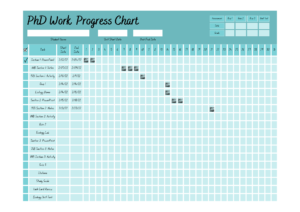
At subsequent PhD progress meetings you should present a brief introduction (one or two slides) to remind the committee of your research area – don’t expect them to recall everything from the last meeting, but no need to go into great detail. Aim to put your work in context.
Show your current working objective in the form of a block diagram. This will set the boundary for the presentation and discussion. This will help the committee members to focus on the specified objective. For example in the figure below the candidate is focusing on the “Wheeled mobile Robot” objective in Robot Path Planning.
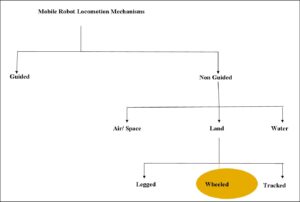
Make sure you are comfortable moving back and forth among your slides. Do not cross the time limit. Add photographs of any field visits for data collection , or conference presentations in your presentation slides. If you had any interactions with domain experts in your area then add interaction details with a date. If you have visited any organization as a resource person relating to your Ph.D. work with your supervisor then add that details.
Seek advice from your committee members during the meeting. Note down all the suggestions by yourself or ask one of your research colleagues to note the same. This is highly desirable, almost to the point that you should make it mandatory. Give a timeline of your plans. What will you be doing over the next month, and what do you hope to accomplish before your next meeting in the next six months’ time.
Keep additional slides along with your regular slides. Get into additional slides detail if any clarifications are sought on any equations or algorithms etc.
Additional slides can be presented as follows:
i) The equipment details you are planning to purchase or currently using for implementation.
ii) The Algorithms which you have implemented or planning to implement.
iii) The mathematical model you have developed, or
iv) Any slides that you think are important but do not have time to cover at the end of your presentation.
Here are some tips regarding the presentation, including time management, devices, backup, laptop usage, uploading PowerPoint, video, and audio:
- Practice your presentation beforehand to ensure it fits within the allocated time.
- Use a timer or stopwatch during practice sessions to gauge your pace.
- Be mindful of the time during the actual presentation and make necessary adjustments to stay on track.
- Ensure your laptop or presentation device is in good working condition.
- Carry a backup copy of your presentation on a USB drive or cloud storage.
- Test the compatibility of your presentation files with the equipment at the presentation venue in advance.
- Close any unnecessary applications or notifications on your laptop to avoid distractions.
- Disable sleep mode or screensavers to prevent interruptions during the presentation.
- Familiarize yourself with the laptop’s function keys or shortcuts for adjusting display settings, volume, etc.
- Save your PowerPoint presentation in a compatible format (e.g., PPT or PPTX).
- Verify that all embedded media (images, videos, audio) are properly linked and functional.
- If possible, upload your presentation to the venue’s computer system before the session to avoid last-minute technical issues.
- Check the audio and video components of your presentation beforehand to ensure they work properly.
- If you plan to play a video, ensure it is in a compatible format and smoothly integrated into your presentation.
- Test the sound levels to ensure audibility for everyone in the room.
Additional tips (from personal experience):
- Rehearse your presentation multiple times to build confidence and familiarity with the material.
- Prepare cue cards or key points to refer to if needed, but avoid excessive reliance on them.
- Maintain eye contact with the audience to engage them and convey confidence.
- Speak clearly and project your voice to ensure everyone can hear you.
- Use visual aids and diagrams to enhance understanding and clarify complex concepts.
- Incorporate storytelling or real-life examples to make your presentation more engaging.
- Practice smooth transitions between slides and maintain a logical flow throughout.
- Be prepared to answer questions and engage in discussions following your presentation.
Remember, the more prepared and confident you are, the better you can deliver your presentation effectively.
After the PhD Progress Presentation Meeting
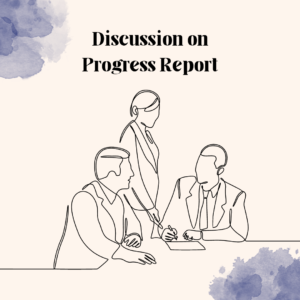
End your PhD progress committee meeting with a summary of what you have discussed, common points that you have reached and an action plan for the next six months. Your action plan needs to have “actionable” items, specifically what milestones you will work towards after the meeting and approximate timelines.
A written summary of the PhD progress committee meeting will be prepared by the supervisor and the committee, and that will be sent to the University. You will receive a copy of this and a copy will be placed in your research file.
Send an email note to each of your committee members through your supervisor to thank them for their time, and summarize the action items or milestones you agreed to. This will give your committee members another chance to give you feedback or suggestions.
During the meeting, you might have accepted to complete some implementation before the next meeting, but you may run out of time or you may not get any ideas regarding implementation. In such situations, have a discussion with your supervisor and the committee members and discuss the challenges faced by you. They may either extend the implementation time or ask you to change the methodology of implementation.
Simply do not wait for suggestions from committee members till the next PhD progress presentation meeting. In order to build trust between you and your committee members, you need to take committee members and your supervisor into confidence before taking any major decisions.
In the meeting, the committee might have suggested publishing your work in a quality conference or journal for better citations. Selecting a reputable journal and avoiding predatory conferences and journals is crucial for maximizing the visibility and impact of your research article.
By publishing in a respected journal, you increase the likelihood of attracting a broader and more qualified readership, thus increasing the chances of your article being cited by other researchers. Choosing the right journal involves considering factors such as the journal’s scope, target audience, impact factor, indexing in reputable databases, peer-review process, and overall reputation in the field.
Additionally, it is important to stay vigilant and avoid predatory conferences and journals that may engage in unethical practices or lack rigorous peer-review processes. These predatory outlets may hinder the credibility and recognition of your work. By carefully selecting a reputable journal, you position your research for greater exposure, credibility, and citation potential.
Visit my articles on ” How to identify and avoid predatory conferences and journals ” and “ Identifying Reputable journals for your research paper “. These articles will help you in getting your articles cited by many authors.
Here is an email template which you can communicate to your doctoral committee members in case you fail to keep the deadline or are unable to work on the ideas you proposed. Please take consent from your supervisor before sending any communication to Doctoral Committee members.
Improving both oral presentation and visual presentation skills is crucial for effective communication. To enhance your oral presentation skills, focus on aspects such as clarity, organization, and delivery. Practice speaking clearly, using appropriate tone and volume, and engaging with your audience. Additionally, consider refining your body language, utilizing effective gestures, and maintaining eye contact. For further guidance and resources on honing your oral presentation skills, you may explore reputable platforms and online courses available in this domain.
When it comes to visual presentation skills, it is essential to create visually appealing and impactful slides or visuals. Pay attention to design elements, such as color schemes, fonts, and layout, to ensure coherence and readability. Utilize visuals, such as graphs, charts, and images, to convey information effectively. Incorporate appropriate animations or transitions to enhance the flow and engagement of your presentation. To access valuable tips, techniques, and tools for enhancing your visual presentation skills, you can explore recommended platforms and tutorials available online.
If you are interested in further developing your oral presentation skills, I recommend checking out this comprehensive course on oral presentation skills . It covers essential techniques, strategies, and practical exercises to help you deliver impactful presentations confidently. Likewise, if you want to enhance your visual presentation skills, you may find this resource on v isual presentation design highly beneficial. It provides valuable insights, best practices, and examples to create visually stunning and effective presentations. Feel free to explore these resources to elevate your presentation skills and captivate your audience.
Presenting your PhD progress report to the doctoral committee can be a daunting task, but it is an essential part of your PhD journey. The committee is there to provide guidance and support, ensuring that you are on track to complete your dissertation within a reasonable time. It is crucial to approach the committee meeting with a positive attitude and view it as an opportunity to receive productive advice for your future research.
Remember that the presentation of the progress report to the committee happens in three stages: before, during, and after the meeting. The preparation of the report should be meticulous and thoughtful, and during the meeting, you should be open to constructive feedback and suggestions. After the meeting, you should take note of the committee’s recommendations and use them to shape your future research endeavours.
As you move forward in your career, the support and guidance of the doctoral committee will likely continue to be a valuable resource. By effectively presenting your progress report to the committee, you can make the most of this opportunity and receive the guidance you need to succeed in your PhD program.
Frequently Asked Questions
Research Objective: Clearly state the objective of your research and the problem you are addressing. Methodology: Provide a brief description of the methodology or approach you are using to conduct your research. Key Findings: Highlight the major findings or results you have obtained so far in your research. Progress Update: Summarize the progress you have made during the past six months, highlighting significant achievements or milestones reached. Challenges: Briefly mention any challenges or obstacles you have encountered in your research and how you are addressing them. Future Plans: Outline your planned next steps and future goals for your research, including anticipated timelines or milestones. Relevance and Impact: Discuss the relevance and potential impact of your research in your field or discipline. Support Needed: Specify any specific support, resources, or expertise you require to further advance your research.
To effectively demonstrate a software-based project during the presentation: Have the demo prepared and functional Show a video demonstration if the software is not available or requires specific conditions Focus on showcasing key features and functionalities Provide context and explain the purpose of the software
Include only the necessary level of detail in the background section of your presentation, focusing on what is directly relevant to your research and the specific objectives you will be discussing. Keep it concise and provide enough context to help the doctoral committee members to understand the significance and motivation of your work without delving into unnecessary details.
Maintain open and regular communication with your supervisor throughout the research process. Share progress updates, challenges, and findings with your supervisor in a timely manner. Discuss any potential issues or deviations from the original plan as soon as they arise. Seek feedback and guidance from your supervisor at various stages of your research. Keep your supervisor informed about any changes in methodology, data, or results. Address any concerns or questions from your supervisor before the committee meeting to align expectations.
The types of questions you can expect from committee members regarding your research plan may include: Clarification questions seeking a deeper understanding of your research objectives, methodology, or proposed experiments. Questions about the theoretical framework or literature review supporting your research. Inquiries about the feasibility and potential limitations of your proposed research. Questions related to the significance and impact of your research in the field. Suggestions for alternative approaches or methodologies to consider. Questions about the expected timeline and milestones for your research. Inquiries about potential ethical considerations or data management strategies. Questions exploring the potential implications and practical applications of your research. Requests for additional details or explanations on specific aspects of your research plan. Questions about the expected contributions of your research to the existing body of knowledge in your field.
When responding to suggestions and feedback given by the committee members during the meeting: Listen actively and attentively to understand the suggestions and feedback. Thank the committee members for their input and valuable insights. Remain open-minded and receptive to different perspectives and ideas. Clarify any points of confusion or seek further clarification, if needed. Acknowledge the validity of the suggestions and show a willingness to consider them. Provide thoughtful responses that demonstrate your understanding of the suggestions. Clearly articulate your rationale if you choose not to implement a specific suggestion. Engage in constructive discussions and ask follow-up questions, if appropriate. Demonstrate your ability to integrate feedback into your research plan or adjust your approach. Express gratitude for the committee members’ support and guidance throughout the process.
Lack of Clear Objectives: If your progress presentation fails to clearly define and articulate the objectives of your research, it may be rejected. The committee expects a clear understanding of what you aim to achieve and the significance of your research goals. Inadequate Progress: Insufficient progress made during the specified period can lead to rejection. The committee expects tangible advancements in your research within the given timeframe. If there is a lack of substantial work or limited progress, they may question the feasibility or dedication to your research. Methodological Issues: If there are flaws in your research methodology or data collection techniques, the committee may reject your progress presentation. It is essential to demonstrate a robust and well-designed research approach that aligns with the requirements of your field. Poor Presentation Skills: Your presentation skills play a crucial role in conveying your research effectively. If your presentation lacks clarity, coherence, or fails to engage the audience, it may lead to rejection. Effective communication and the ability to present complex ideas in a concise and understandable manner are vital. Inadequate Literature Review: A comprehensive literature review is expected in a progress presentation. If your review of existing literature is incomplete, lacks depth, or fails to address relevant studies, your presentation may be rejected. It is essential to showcase a thorough understanding of the existing research and its relationship to your work. Failure to Address Committee Feedback: If you neglect to incorporate previous feedback and suggestions from the committee, it may result in rejection. The committee expects you to demonstrate the ability to reflect on and address their recommendations, showing your commitment to improving your research. Remember, the specific parameters for rejection may vary depending on your academic institution and the expectations set by your doctoral committee. It is crucial to consult your supervisor and committee members for clear guidelines and expectations for your progress presentation.
Upcoming Events
- Visit the Upcoming International Conferences at Exotic Travel Destinations with Travel Plan
- Visit for Research Internships Worldwide

Leave a Reply Cancel reply
You must be logged in to post a comment.
Recent Posts
- EditPad Research Title Generator: Is It Helpful to Create a Title for Your Research?
- Are Postdoctoral Fellowships Taxable? A Guide to Understanding Tax Implications
- How to Get Off-Cycle Research/Academic Internships
- How to End Your Academic/Research Internship?
- PhD or Industry Job? A Comprehensive Career Guide
- All Blog Posts
- Research Career
- Research Conference
- Research Internship
- Research Journal
- Research Tools
- Uncategorized
- Research Conferences
- Research Journals
- Research Grants
- Internships
- Research Internships
- Email Templates
- Conferences
- Blog Partners
- Privacy Policy
Copyright © 2024 Research Voyage
Design by ThemesDNA.com

Writing a progress/status report
By michael ernst, january, 2010.
Writing a weekly report about your research progress can make your research more successful, less frustrating, and more visible to others, among other benefits.
One good format is to write your report in four parts:
- Quote the previous week's plan. This helps you determine whether you accomplished your goals.
- State this week's progress. This can include information such as: what you have accomplished, what you learned, what difficulties you overcame, what difficulties are still blocking you, your new ideas for research directions or projects, and the like.
- Give the next week's plan. A good format is a bulleted list, so we can see what you accomplished or did not. Try to make each goal measurable: there should be no ambiguity as to whether you were able to finish it. It's good to include longer-term goals as well.
- Give an agenda for the meeting. Some people like to send this as a separate message, which is fine.
The report need not be onerous. It can be a few paragraphs or a page, so it shouldn't take you long to write. Minimize details that are not relevant to your audience, such as classwork and the like, in order to keep the report focused; you will spend less time writing it, and make it more likely to be read.
Writing the progress report has many benefits.
Writing the report will make you more productive, because it will force you to think about your work in a manner concretely enough to write down. Any time that you spend organizing your thoughts will more than pay itself back in better understanding and improved productivity. When a project is complete, it is all too easy to forget some of your contributions. You can look back over your progress reports to remember what was difficult, and to think about how to work more productively in the future. You may be able to re-use some of the text when writing up your results.
Writing the report will make your meetings more productive. When you have a weekly research meeting, the report should be sent 24 hours in advance, to help everyone prepare. (Two hours is not an acceptable alternative: it does not let everyone — both you and others — mull over the ideas.) Don't delay your report because you want to wait until you have better results to report. Instead, send the report on schedule, and if you get more results in the next 24 hours, you can discuss those at the meeting.
Writing the report will give you feedback from a new point of view. The report enables others outside your research project to know what you are doing. Those people may respond with ideas or suggestions, which can help get you unstuck or give you additional avenues to explore. It also keeps you on their radar screen and reminds them of your work, which a good thing if you don't meet with them frequently. (For PhD students, a periodic report to the members of your thesis committee can pay big dividends.)
Writing the report helps explain (to yourself especially, but also to others) how you spent your time — even if there isn't as much progress as you would have preferred, you can see that you did work hard, and how to be more efficient or effective in the future.
If your meetings are more frequent than weekly, then the progress report should also be more frequent. If your meetings are less frequent, it's a good idea to still send a progress report each week.
Important tip: Throughout the day, maintain a log of what you have done. This can be a simple text file. You can update it when you start and end a task, or at regular intervals throughout the day. It takes only a moment to maintain the log, and it makes writing the report easy. By contrast, without a log you might forget what you have done during the week, and writing the report could take a long time.
Back to Advice compiled by Michael Ernst .

- Undergraduate
- Master’s
- Areas of Focus
- Centers + Institutes
- Labs + Facilities
- Featured Research
- Undergraduate Research
- Graduate Group
- Open Faculty Positions
- Diversity and Inclusion
- Outreach Mission
- Local Programs
- Global Programs
- Why Penn Bioengineering?
- Bioengineering Blog
- Penn Engineering Blog
- Seminars + Events
- Visiting BE
- Make a Gift
- Current Students
- Annual PhD Progress Report
Ph.D. Student Handbook
Annual ph.d. progress report.
Starting in their second year, students will meet with a mentoring committee annually. Prior to candidacy, the mentoring committee will be composed of their Qualifying committee. After candidacy, the mentoring committee will be composed of their Dissertation committee, which depending on the nature of a student’s thesis may include members of the Qualifying committee. At least one week prior to the annual meeting (which also includes the candidacy exam), the student will provide a brief progress report (3-page max, excluding non-mandatory figures), an updated CV, and a copy of their IDP. At the beginning of the meeting, the student will meet alone with the committee, followed by a meeting of the advisor(s) with the committee. The committee chair will fill out the PhD Committee Meeting Report.
Access the Progress Report Submission form her e.
The purpose of the Dissertation Committee is to provide objective advice and fresh points of view to the student and Advisor. A lively discussion may be expected at these meetings, which is sure to benefit the student and the student’s research. Committee meetings are also important for ensuring that the student is: i) on schedule to complete the Thesis in an appropriate time frame, including maintaining the appropriate balance of experiments, analysis, writing, and dissemination; ii) thinking about and effectively pursuing post-graduation career plans; and iii) at the appropriate time is given permission to defend.
Doctoral Program:
- Student Directory
- Fellowships + Support
- New Students
- Transfer Credits
- Degree Requirements
- M.D. + Ph.D.
- V.M.D. + Ph.D.
- Certificate Programs
- Diversity Advisors
- Academic Forms, Advising Resources and Feedback Forms
Your BE Contact:
Kathleen Venit Associate Director, Graduate Programs 240 Skirkanich Hall
Graduate Student Groups:
Graduate Association of Bioengineers
Graduate Student Engineering Group

Study at Cambridge
About the university, research at cambridge.
- Undergraduate courses
- Events and open days
- Fees and finance
- Postgraduate courses
- How to apply
- Postgraduate events
- Fees and funding
- International students
- Continuing education
- Executive and professional education
- Courses in education
- How the University and Colleges work
- Term dates and calendars
- Visiting the University
- Annual reports
- Equality and diversity
- A global university
- Public engagement
- Give to Cambridge
- For Cambridge students
- For our researchers
- Business and enterprise
- Colleges & departments
- Email & phone search
- Museums & collections
- Current students
- PhD students
- Progression
- Department of Computer Science and Technology
Sign in with Raven
- People overview
- Research staff
- Professional services staff
- Affiliated lecturers
- Overview of Professional Services Staff
- Seminars overview
- Weekly timetable
- Wednesday seminars
- Wednesday seminar recordings ➥
- Wheeler lectures
- Computer Laboratory 75th anniversary ➥
- women@CL 10th anniversary ➥
- Job vacancies ➥
- Library resources ➥
- How to get here
- William Gates Building layout
- Contact information
- Department calendar ➥
- Accelerate Programme for Scientific Discovery overview
- Data Trusts Initiative overview
- Pilot Funding FAQs
- Research Funding FAQs
- Cambridge Ring overview
- Ring Events
- Hall of Fame
- Hall of Fame Awards
- Hall of Fame - Nominations
- The Supporters' Club overview
- Industrial Collaboration
- Annual Recruitment Fair overview
- Graduate Opportunities
- Summer internships
- Technical Talks
- Supporter Events and Competitions
- How to join
- Collaborate with Us
- Cambridge Centre for Carbon Credits (4C)
- Equality and Diversity overview
- Athena SWAN
- E&D Committee
- Support and Development
- Targeted funding
- LGBTQ+@CL overview
- Links and resources
- Queer Library
- women@CL overview
- About Us overview
- Friends of women@CL overview
- Twentieth Anniversary of Women@CL
- Tech Events
- Students' experiences
- Contact overview
- Mailing lists
- Scholarships
- Initiatives
- Dignity Policy
- Outreach overview
- Women in Computer Science Programme
- Google DeepMind Research Ready programme overview
- Accommodation and Pay
- Application
- Eligibility
- Raspberry Pi Tutorials ➥
- Wiseman prize
- Research overview
- Application areas
- Research themes
- Algorithms and Complexity
- Computer Architecture overview
- Creating a new Computer Architecture Research Centre
- Graphics, Vision and Imaging Science
- Human-Centred Computing
- Machine Learning and Artificial Intelligence
- Mobile Systems, Robotics and Automation
- Natural Language Processing
- Programming Languages, Semantics and Verification
- Systems and Networking
- Research groups overview
- Energy and Environment Group overview
- Declaration
- Publications
- Past seminars
- Learning and Human Intelligence Group overview
- Technical Reports
- Admissions information
- Undergraduate admissions overview
- Open days and events
- Undergraduate course overview overview
- Making your application
- Admissions FAQs
- Super curricular activities
- MPhil in Advanced Computer Science overview
- Applications
- Course structure
- Funding competitions
- Prerequisites
- PhD in Computer Science overview
- Application forms
- Research Proposal
- Funding competitions and grants
- Part-time PhD Degree
- Premium Research Studentship
- Current students overview
- Part IB overview
- Part IB group projects overview
- Important dates
- Design briefs
- Moodle course ➥
- Learning objectives and assessment
- Technical considerations
- After the project
- Part II overview
- Part II projects overview
- Project suggestions
- Project Checker groups
- Project proposal
- Advice on running the project
- Progress report and presentation
- The dissertation
- Supervisor briefing notes
- Project Checker briefing notes
- Past overseer groups ➥
- Part II Supervision sign-up
- Part II Modules
- Part II Supervisions overview
- Continuing to Part III overview
- Continuing to Part III: 2023 guidance
- Part III of the Computer Science Tripos
- Overview overview
- Information for current Masters students overview
- Special topics
- Part III and ACS projects overview
- Submission of project reports
- ACS projects overview
- Guidance for ACS projects
- Part III projects overview
- Guidance for Part III projects
- Preparation
- Registration
- Induction - Masters students
- PhD resources overview
- Deadlines for PhD applications
- Protocol for Graduate Advisers for PhD students
- Guidelines for PhD supervisors
- Induction information overview
- Important Dates
- Who is here to help
- Exemption from University Composition Fees
- Being a research student
- Researcher Development
- Research skills programme
- First Year Report: the PhD Proposal
- Second Year Report: Dissertation Schedule
- Third Year Report: Progress Statement
- Fourth Year: writing up and completion overview
- PhD thesis formatting
- Writing up and word count
- Submitting your dissertation
- Papers and conferences
- Leave to work away, holidays, and intermission
- List of PhD students ➥
- PAT, recycling, and Building Services
- Freshers overview
- Cambridge University Freshers' Events
- Undergraduate teaching information and important dates
- Course material 2023/24 ➥
- Course material 2024/25 ➥
- Exams overview
- Examination dates
- Examination results ➥
- Examiners' reports ➥
- Part III Assessment
- MPhil Assessment
- Past exam papers ➥
- Examinations Guidance 2022-23
- Marking Scheme and Classing Convention
- Guidance on Plagiarism and Academic Misconduct
- Purchase of calculators
- Examinations Data Retention Policy
- Guidance on deadlines and extensions
- Mark Check procedure and Examination Review
- Lecture timetables overview
- Understanding the concise timetable
- Supervisions overview
- Part II supervisions overview ➥
- Part II supervision sign-up ➥
- Supervising in Computer Science
- Supervisor support
- Directors of Studies list
- Academic exchanges
- Advice for visiting students taking Part IB CST
- Summer internship: Optimisation of DNN Accelerators using Bayesian Optimisation
- UROP internships
- Resources for students overview
- Student SSH server
- Online services
- Managed Cluster Service (MCS)
- Microsoft Software for personal use
- Installing Linux
- Part III and MPhil Machines
- Transferable skills
- Course feedback and where to find help overview
- Providing lecture feedback
- Fast feedback hotline
- Staff-Student Consultative Forum
- Breaking the silence ➥
- Student Administration Offices
- Intranet overview
- New starters and visitors
- Forms and templates
- Building management
- Health and safety
- Teaching information
- Research admin
- Miscellaneous
- Fourth Year: writing up and completion
- PhD resources
All candidates for the PhD Degree are admitted on a probationary basis. A student's status with the Student Registry is that he or she will be registered for the CPGS in Computer Science . At the end of the first academic year, a formal assessment of progress is made. In the Department of Computer Science and Technology, this takes the form of a single document of no more than 10,000 words in length, exclusive of tables, bibliography and appendices.
The document is principally a PhD Proposal . That is, a document that demonstrates a clear path from the candidate's current position to a complete PhD thesis at the end of the third year. The document has two purposes: (i) to help the candidate to reflect on and plan their research project and (ii) to allow the Computer Laboratory to assess the student's progress and planned research.
In the document, the candidate should do the following:
- Identify a potential problem or topic to address for the PhD.
- identifying the seminal prior research in the topic area
- the most closely related prior work, and
- their strengths and weaknesses.
The goal is to show the limitations (or lack) of previous work. One method that could be employed to do this is to provide both a taxonomy of prior work and a gap analysis table: a table whose rows are the closest related work, the columns are the desired attributes of the solution, and each table entry is a Yes or a No. This would then clearly show that no prior work meets all the desired attributes.
This section of the document might be expected to form the basis of part of the candidate's final PhD thesis.
Candidates should have already done some preliminary research. This may be early attempts at proofs, a detailed analysis of existing methods, a critique of existing systems, assembly and testing of investigative apparatus, conduct of a pilot experiment, etc. This section of the document may form the basis of a chapter of the final PhD thesis. It is common for the candidate to have produced an academic paper (even if this is a minor paper for a workshop, for example), where they are the main author. The paper does not need to have been published, but the assessors should be able to see that it is of potentially publishable quality. Such a paper can be submitted as an appendix to the document; in this case the material in the paper should not be reproduced in the document, but should be summarised briefly in a self-contained way.
This should indicate, at a high level, the research that might be undertaken in the second and third years of the PhD. It needs to show that there is a viable route to a thesis in two years' time. In particular, it must state the specific research question or questions that are being addressed. If there are more than one question being addressed, it needs to be made clear how they are interconnected and how answering them would result in a coherent thesis story. They need to also be accompanied with a brief discussion of why they are important and interesting questions that are worthy of a Cambridge PhD, and why they are new (the gap analysis table could be used for this). Next, the candidate needs to describe the proposed method of attacking the questions, for example, by listing the major steps to completion through the next two years.
Some candidates find it useful to structure this as a cohesive one-page summary of the proposed thesis, with a tentative title, a paragraph setting the context, and three or four paragraphs describing chunks of the proposed research, each of which could be the basis for an academic paper and each of which could be expected to be a chapter of the final thesis. The chapters should make a cohesive overarching narrative of the thesis, rather than be stand-alone pieces of work.
A paragraph identifying criteria for success is recommended where the candidate explains how they will convince the research community that their approach is successful.
Potential risks are recommended to be identified: what could derail this methodology (technically) and if this happens what is plan B?
- Timeplan: provide a detailed timetable, with explicit milestones for each term in the next two years against which the candidate will measure their progress. This would ideally include technical tasks that are planned to be accomplished during each time chunk.
It is essential that the supervisor(s) agrees that the document may be submitted. The document will be read by two other members of staff (assessors), who will interview the student about the content of the document in a viva. It should therefore give sufficient information that the assessors can satisfy themselves that all is well. It is expected that the interview will take place before the end of the first year.
Submission deadlines (electronic)
- For students admitted in Michaelmas Term, by June 30, 23:59
- For students admitted in Lent Term, October 30, 23:59
- For students admitted in Easter Term, by January 30, 23:59
All submissions should be made electronically via the filer.
Electronic version (in PDF format) should be provided via the PhD report and thesis upload page . This deposits uploaded files on the departmental filer at /auto/anfs/www-uploads/phd = \\filer.cl.cam.ac.uk\webserver\www-uploads\phd.
Students intending to take up research placements during the vacations which begin on, before, or shortly after the submission deadlines must submit their report one month before departure to enable the examination process to be completed before the internship begins . No other extensions will be permitted unless otherwise authorized by the Secretary of the Degree Committee.
Oral examination
The student will be invited to discuss the documents with two assessors appointed by the student's principal supervisor. Neither of the assessors should be the student's principal supervisor though one may be the student's second advisor. Occasionally, the principal supervisor may be invited to clarify elements of the PhD Proposal and to attend the viva as an observer.
Where the initial PhD Proposal document is unsatisfactory, the assessors must ask for a revised submission and arrange a further discussion. Where the PhD Proposal is acceptable, it may still help the student to record suggested modifications in a final version of the Proposal. A copy of the revised document must be submitted to the Secretary of the Degree Committee.
The PhD Proposal document is internal to the Laboratory. However, since it is the basis for formal progress reports including registration for the PhD Degree and those made to funding bodies, assessors should endeavour to arrange a meeting where the documents should be assessed and discussed by the end of the student's first year at the latest. The Secretary of the Degree Committee should be informed of the result by the assessors and by the supervisor on the Postgraduate Feedback and Reporting System as soon as possible thereafter.
The report will be considered by the Degree Committee which will make its recommendations on the registration of the student to the Board of Graduate Studies.
In those cases where the student's progress is wholly inadequate, the supervisor should give them a written warning by 15 September (or the appropriate corresponding date - 15 December or 15 March) that they are in danger of termination, with copy to the Secretary of the Degree Committee.
The word limit is a maximum; it is not a target. Successful PhD Proposal documents can be significantly shorter than the limit. Writing within the word limit is important. It is part of the discipline of producing reports. When submitting reports (and the final PhD thesis), students will be required to sign a Statement of Word Length to confirm that the work does not exceed the limit of length prescribed (above) for the CPGS examination.
Originality
Attention is drawn to the University's guidance concerning plagiarism. The University states that "Plagiarism is defined as submitting as one's own work that which derives in part or in its entirety from the work of others without due acknowledgement. It is both poor scholarship and a breach of academic integrity." The Faculty's guidance concerning plagiarism and good academic practice can be found at https://www.cl.cam.ac.uk/teaching/exams/plagiarism.html .
Reports may be soft-bound in comb-binding or stapled.
Secretary of the Degree Committee September 2013, updated September 2021, updated March 2022
Department of Computer Science and Technology University of Cambridge William Gates Building 15 JJ Thomson Avenue Cambridge CB3 0FD
Information provided by [email protected]
Privacy policy
Social media
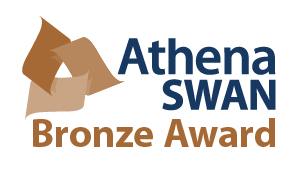
© 2024 University of Cambridge
- Contact the University
- Accessibility
- Freedom of information
- Privacy policy and cookies
- Statement on Modern Slavery
- Terms and conditions
- University A-Z
- Undergraduate
- Postgraduate
- Research news
- About research at Cambridge
- Spotlight on...
Secondary Menu
- Research Progress Report/Prelim Document
The preparation and submission of the Research Progress Report/Prelim Document emphasizes your research accomplishment at an early stage. The report also provides practice in technical writing, an important part of graduate training. The report serves as a first concrete step toward the preliminary examination, and the revised and updated version will also serve as the written document that guides the examination. As such, the report demonstrates your accomplished research and an understanding of the project, and is used to measure (and correct) your organizational and technical writing ability. It should be completed with minimal input from the research advisor.
A written prelim document will be submitted by each student to the Director of Graduate Studies Assistant no later than March 1 of the Spring semester of year two. If a student’s affiliation with a lab is delayed due to not completing the required coursework stipulated in Section C or placement on academic probation due to poor academic performance, the preliminary exam will not be deferred.
The report will be evaluated by all members of the student’s supervisory committee, each providing critical comments and suggestions for revisions, both on the prelim document itself and the Chemistry Thesis Assessment Protocol (ChemTAP) worksheets provided. The report and comments will be returned to the student by March 15. A final and updated version of this report will serve as the written document for the preliminary examination and will be considered part of the examination.
Report Structure
The report should normally include the following sections. The body of the document should contain no more than 2500 words, not counting figures, references, and any appended experimental details. Students are encouraged to consult the ACS Style Guide and/or research journals in their research area for guidance on matters of style and format.
- Abstract of no more than 100 words.
- Introduction section that should state the broad goals and specific aims of the research, point to the significance and/or relevance of the research, and should provide sufficient background to place the research in the context of past and ongoing work in the research area, e.g. the literature.
- Methods - brief section outlining relevant methods employed in the research, with expanded experimental details appended outside the body of the document as necessary.
- Results - this section should summarize progress to date.
- Discussion section
- Future Work
When submitting the final draft of preliminary exam document to the committee the student should also provide a summary of their changes.
- Chem Connect Lecture Series
- Related Groups
- Instrument Facilities
- Room Reservations
- Use of Facilities
- Guidance on Acceptable Use of AI
- Proposal and Grant Development
- Location & Directions
- Safety Manual
- Diagnostic Quiz
- Minor Requirements
- B.S. Requirements
- A.B. Requirements
- Graduation with Distinction
- Undergraduate Awards
- Transfer Credits
- Summer Research Opportunities
- Finding a Research Director and Group
- Requirements
- Registration
- Study Abroad
- Duke Community Standard
- Undergraduate Handbook
- Writing a Senior Thesis
- Appendix on Safety
- Oral Reports
- Poster Sessions
- Sources for Scientific Writing
- Tutors and Chemistry Help
- Trinity Ambassadors
- Lab Rotations
- Responsible Conduct in Research Training
- Teaching Requirement
- Supervisory Committee
- Preliminary Examination
- Oral Presentation Requirement
- Propositional Examination
- Annual Progress Reporting
- Dissertation & Final Examination
- Chemistry Guidance on Acceptable Use of AI for Milestone Exams
- Frequently Asked Questions
- Graduate Recruitment Weekend
- Learn more about Chemistry, Duke and Durham
- Financial Support
- Living in Durham
- Useful Resources
- Fellowship Opportunities
- Student Organizations
- Admitted students
- Defending soon?
- Departmental Mentoring Statement
- Biomolecular Structure & Function
- Nanoscience & Materials
- Theoretical
- Mass Spectrometry
- Spectroscopy and Other Instruments
- Sample Submissions
- Instrument Rates
- Research & Discoveries
- Computing Resources
- Primary Faculty
- Secondary Faculty
- Research, Teaching, Adjunct Faculty
- Emeritus Faculty
- Researchers
- Graduate Students
- Assisting Duke Students
- For Our Students

This site is fully related to medical laboratory information for public and health care professionals.
PhD Semester Progress Report- Introduction, Contents, and Keynotes
Introduction.
Table of Contents
Writing a PhD semester progress report involves summarizing your academic and research activities over the semester. This report is important for tracking your progress, identifying challenges, and planning future work.
Contents for PhD Semester Progress Report
Here’s a guide on how to structure and write an effective PhD semester progress report:
Title: Include the title of your report. Name: Your full name. Program: Your PhD program. Advisor’s Name: Your advisor’s full name. Date: The submission date. Semester: Specify the semester (e.g., Fall 2023).
Purpose: Briefly state the purpose of the progress report. Overview: Give a quick overview of your PhD topic or area of study.
Academic Progress
Courses Taken: List the courses you have taken this semester, including any seminars or workshops. Include grades if they are available. Skills Developed: Discuss any new skills you have acquired that are relevant to your research.
Research Progress
Objectives: Outline the main research objectives for the semester. Methodology: Briefly describe the methods used for research. Results: Present the results you have achieved so far. Include preliminary data, if applicable. Challenges and Solutions: Discuss any challenges you faced and how you addressed them.
Meetings and Interactions
Advisor Meetings: Summarize the frequency and content of your meetings with your advisor. Collaborations: Mention any collaborations with other researchers or institutions. Conferences and Presentations: List any academic conferences you attended, along with presentations or posters you contributed.
Future Work
Next Steps: Outline your plans for the next semester or phase of your research. Goals: Set specific goals or milestones you aim to achieve.
Summary: Conclude with a summary of your progress and any insights or reflections on your PhD journey so far.
Appendices (if necessary)
Additional Data: Include any supplementary data or details that support your report, such as charts, graphs, or detailed findings. Bibliography: List any references or literature that have been significant to your research.
Formatting Tips
Clarity and Conciseness: Use clear and concise language to ensure your report is easily understandable. Consistency: Maintain a consistent format throughout the report in terms of fonts, headings, and layout. Proofreading: Thoroughly proofread your report to eliminate any grammatical or typographical errors. This structure helps to organize your thoughts and provides a clear record of your activities and achievements. Adjust the categories based on your specific research and academic requirements.
Keynotes on PhD Semester Progress Report
Writing a PhD progress report is a crucial part of documenting the development and accomplishments in your research project. Here are some key notes to consider when preparing your report:
- Purpose and Audience Purpose: Understand that the primary purpose of a progress report is to showcase your accomplishments, detail your plans, and demonstrate your ongoing commitment to the project. Audience: Tailor your report to your audience, which usually includes your supervisor, department head, and possibly other faculty members involved in your program.
- Clarity and Structure Clear Objective: Start with a clear statement of your research objectives. Make sure the goals of your project are well-defined and articulate how your activities during the reporting period have advanced these goals. Logical Structure: Organize your report in a logical manner. Typical sections include Introduction, Academic Progress, Research Progress, Challenges and Solutions, Future Work, and Conclusion.
- Comprehensive Content Academic and Research Activities: Include details about courses, seminars, workshops, readings, experiments, and other relevant activities. Results and Findings: Highlight key findings and data. Use figures, tables, and charts to illustrate points clearly. Challenges and Solutions: Discuss any obstacles encountered and how you addressed them. This shows your problem-solving capabilities and resilience. Future Directions: Specify what steps you plan to take next in your research. This shows foresight and planning.
- Consistency and Accuracy Consistency: Use a consistent format for headings, subheadings, font sizes, and styles throughout the report. This enhances readability and professionalism. Accuracy: Ensure all data and factual information are accurate. Cite sources appropriately if you refer to other works.
- Feedback Incorporation Advisory Meetings: Document the feedback received during meetings with your advisor and any other committee members. Reflect on how this feedback has shaped your project. Responsive Changes: Show how you have incorporated or plan to incorporate this feedback into your research.
- Professional Presentation Formal Language: Use formal academic language and avoid colloquialisms or overly casual phrases. Proofreading: Thoroughly proofread your document to eliminate grammatical errors, typos, and other mistakes. Consider using professional editing software or assistance.
- Regular Updates Timeliness: Submit your progress report according to the timeline stipulated by your department. Regular reporting helps avoid last-minute rushes and ensures thorough documentation of your progress.
- Ethical Considerations Honesty: Be honest about what has and has not been achieved. Transparency in reporting problems or delays is crucial for building trust with your advisory committee.
- Appendices and Supplementary Materials Supporting Documents: Include any additional documents that support your narrative. This can be raw data, full survey results, detailed figures, or scripts used for analysis. By keeping these key points in mind, you can craft a comprehensive and effective PhD progress report that not only documents your progress but also strategically plans for future success in your research endeavors.
Read Also...
- Biomedical Science and Research: Introduction, and Keynotes
- SARS-CoV-2 RT-PCR Laboratory Proficiency Testing…
- Journal Articles Summarizing Tips-Introduction,…
- SOP, Personal Statement, and Letter of Motivation:…
- Some key points to consider during the reviewing a…
- Drug of Abuse (DOA) Panel: Introduction, Test Panel,…
- CT IVU: Introduction, Uses, Centers in Kathmandu,…
- Thyroid Scan (Thyroid Scintigraphy): Introduction,…
Leave a Comment Cancel reply
Save my name, email, and website in this browser for the next time I comment.
If you opt in above we use this information send our latest articles and medical notes.
- Privacy Policy

Home » Research Report – Example, Writing Guide and Types
Research Report – Example, Writing Guide and Types
Table of Contents

Research Report
Definition:
Research Report is a written document that presents the results of a research project or study, including the research question, methodology, results, and conclusions, in a clear and objective manner.
The purpose of a research report is to communicate the findings of the research to the intended audience, which could be other researchers, stakeholders, or the general public.
Components of Research Report
Components of Research Report are as follows:
Introduction
The introduction sets the stage for the research report and provides a brief overview of the research question or problem being investigated. It should include a clear statement of the purpose of the study and its significance or relevance to the field of research. It may also provide background information or a literature review to help contextualize the research.
Literature Review
The literature review provides a critical analysis and synthesis of the existing research and scholarship relevant to the research question or problem. It should identify the gaps, inconsistencies, and contradictions in the literature and show how the current study addresses these issues. The literature review also establishes the theoretical framework or conceptual model that guides the research.
Methodology
The methodology section describes the research design, methods, and procedures used to collect and analyze data. It should include information on the sample or participants, data collection instruments, data collection procedures, and data analysis techniques. The methodology should be clear and detailed enough to allow other researchers to replicate the study.
The results section presents the findings of the study in a clear and objective manner. It should provide a detailed description of the data and statistics used to answer the research question or test the hypothesis. Tables, graphs, and figures may be included to help visualize the data and illustrate the key findings.
The discussion section interprets the results of the study and explains their significance or relevance to the research question or problem. It should also compare the current findings with those of previous studies and identify the implications for future research or practice. The discussion should be based on the results presented in the previous section and should avoid speculation or unfounded conclusions.
The conclusion summarizes the key findings of the study and restates the main argument or thesis presented in the introduction. It should also provide a brief overview of the contributions of the study to the field of research and the implications for practice or policy.
The references section lists all the sources cited in the research report, following a specific citation style, such as APA or MLA.
The appendices section includes any additional material, such as data tables, figures, or instruments used in the study, that could not be included in the main text due to space limitations.
Types of Research Report
Types of Research Report are as follows:
Thesis is a type of research report. A thesis is a long-form research document that presents the findings and conclusions of an original research study conducted by a student as part of a graduate or postgraduate program. It is typically written by a student pursuing a higher degree, such as a Master’s or Doctoral degree, although it can also be written by researchers or scholars in other fields.
Research Paper
Research paper is a type of research report. A research paper is a document that presents the results of a research study or investigation. Research papers can be written in a variety of fields, including science, social science, humanities, and business. They typically follow a standard format that includes an introduction, literature review, methodology, results, discussion, and conclusion sections.
Technical Report
A technical report is a detailed report that provides information about a specific technical or scientific problem or project. Technical reports are often used in engineering, science, and other technical fields to document research and development work.
Progress Report
A progress report provides an update on the progress of a research project or program over a specific period of time. Progress reports are typically used to communicate the status of a project to stakeholders, funders, or project managers.
Feasibility Report
A feasibility report assesses the feasibility of a proposed project or plan, providing an analysis of the potential risks, benefits, and costs associated with the project. Feasibility reports are often used in business, engineering, and other fields to determine the viability of a project before it is undertaken.
Field Report
A field report documents observations and findings from fieldwork, which is research conducted in the natural environment or setting. Field reports are often used in anthropology, ecology, and other social and natural sciences.
Experimental Report
An experimental report documents the results of a scientific experiment, including the hypothesis, methods, results, and conclusions. Experimental reports are often used in biology, chemistry, and other sciences to communicate the results of laboratory experiments.
Case Study Report
A case study report provides an in-depth analysis of a specific case or situation, often used in psychology, social work, and other fields to document and understand complex cases or phenomena.
Literature Review Report
A literature review report synthesizes and summarizes existing research on a specific topic, providing an overview of the current state of knowledge on the subject. Literature review reports are often used in social sciences, education, and other fields to identify gaps in the literature and guide future research.
Research Report Example
Following is a Research Report Example sample for Students:
Title: The Impact of Social Media on Academic Performance among High School Students
This study aims to investigate the relationship between social media use and academic performance among high school students. The study utilized a quantitative research design, which involved a survey questionnaire administered to a sample of 200 high school students. The findings indicate that there is a negative correlation between social media use and academic performance, suggesting that excessive social media use can lead to poor academic performance among high school students. The results of this study have important implications for educators, parents, and policymakers, as they highlight the need for strategies that can help students balance their social media use and academic responsibilities.
Introduction:
Social media has become an integral part of the lives of high school students. With the widespread use of social media platforms such as Facebook, Twitter, Instagram, and Snapchat, students can connect with friends, share photos and videos, and engage in discussions on a range of topics. While social media offers many benefits, concerns have been raised about its impact on academic performance. Many studies have found a negative correlation between social media use and academic performance among high school students (Kirschner & Karpinski, 2010; Paul, Baker, & Cochran, 2012).
Given the growing importance of social media in the lives of high school students, it is important to investigate its impact on academic performance. This study aims to address this gap by examining the relationship between social media use and academic performance among high school students.
Methodology:
The study utilized a quantitative research design, which involved a survey questionnaire administered to a sample of 200 high school students. The questionnaire was developed based on previous studies and was designed to measure the frequency and duration of social media use, as well as academic performance.
The participants were selected using a convenience sampling technique, and the survey questionnaire was distributed in the classroom during regular school hours. The data collected were analyzed using descriptive statistics and correlation analysis.
The findings indicate that the majority of high school students use social media platforms on a daily basis, with Facebook being the most popular platform. The results also show a negative correlation between social media use and academic performance, suggesting that excessive social media use can lead to poor academic performance among high school students.
Discussion:
The results of this study have important implications for educators, parents, and policymakers. The negative correlation between social media use and academic performance suggests that strategies should be put in place to help students balance their social media use and academic responsibilities. For example, educators could incorporate social media into their teaching strategies to engage students and enhance learning. Parents could limit their children’s social media use and encourage them to prioritize their academic responsibilities. Policymakers could develop guidelines and policies to regulate social media use among high school students.
Conclusion:
In conclusion, this study provides evidence of the negative impact of social media on academic performance among high school students. The findings highlight the need for strategies that can help students balance their social media use and academic responsibilities. Further research is needed to explore the specific mechanisms by which social media use affects academic performance and to develop effective strategies for addressing this issue.
Limitations:
One limitation of this study is the use of convenience sampling, which limits the generalizability of the findings to other populations. Future studies should use random sampling techniques to increase the representativeness of the sample. Another limitation is the use of self-reported measures, which may be subject to social desirability bias. Future studies could use objective measures of social media use and academic performance, such as tracking software and school records.
Implications:
The findings of this study have important implications for educators, parents, and policymakers. Educators could incorporate social media into their teaching strategies to engage students and enhance learning. For example, teachers could use social media platforms to share relevant educational resources and facilitate online discussions. Parents could limit their children’s social media use and encourage them to prioritize their academic responsibilities. They could also engage in open communication with their children to understand their social media use and its impact on their academic performance. Policymakers could develop guidelines and policies to regulate social media use among high school students. For example, schools could implement social media policies that restrict access during class time and encourage responsible use.
References:
- Kirschner, P. A., & Karpinski, A. C. (2010). Facebook® and academic performance. Computers in Human Behavior, 26(6), 1237-1245.
- Paul, J. A., Baker, H. M., & Cochran, J. D. (2012). Effect of online social networking on student academic performance. Journal of the Research Center for Educational Technology, 8(1), 1-19.
- Pantic, I. (2014). Online social networking and mental health. Cyberpsychology, Behavior, and Social Networking, 17(10), 652-657.
- Rosen, L. D., Carrier, L. M., & Cheever, N. A. (2013). Facebook and texting made me do it: Media-induced task-switching while studying. Computers in Human Behavior, 29(3), 948-958.
Note*: Above mention, Example is just a sample for the students’ guide. Do not directly copy and paste as your College or University assignment. Kindly do some research and Write your own.
Applications of Research Report
Research reports have many applications, including:
- Communicating research findings: The primary application of a research report is to communicate the results of a study to other researchers, stakeholders, or the general public. The report serves as a way to share new knowledge, insights, and discoveries with others in the field.
- Informing policy and practice : Research reports can inform policy and practice by providing evidence-based recommendations for decision-makers. For example, a research report on the effectiveness of a new drug could inform regulatory agencies in their decision-making process.
- Supporting further research: Research reports can provide a foundation for further research in a particular area. Other researchers may use the findings and methodology of a report to develop new research questions or to build on existing research.
- Evaluating programs and interventions : Research reports can be used to evaluate the effectiveness of programs and interventions in achieving their intended outcomes. For example, a research report on a new educational program could provide evidence of its impact on student performance.
- Demonstrating impact : Research reports can be used to demonstrate the impact of research funding or to evaluate the success of research projects. By presenting the findings and outcomes of a study, research reports can show the value of research to funders and stakeholders.
- Enhancing professional development : Research reports can be used to enhance professional development by providing a source of information and learning for researchers and practitioners in a particular field. For example, a research report on a new teaching methodology could provide insights and ideas for educators to incorporate into their own practice.
How to write Research Report
Here are some steps you can follow to write a research report:
- Identify the research question: The first step in writing a research report is to identify your research question. This will help you focus your research and organize your findings.
- Conduct research : Once you have identified your research question, you will need to conduct research to gather relevant data and information. This can involve conducting experiments, reviewing literature, or analyzing data.
- Organize your findings: Once you have gathered all of your data, you will need to organize your findings in a way that is clear and understandable. This can involve creating tables, graphs, or charts to illustrate your results.
- Write the report: Once you have organized your findings, you can begin writing the report. Start with an introduction that provides background information and explains the purpose of your research. Next, provide a detailed description of your research methods and findings. Finally, summarize your results and draw conclusions based on your findings.
- Proofread and edit: After you have written your report, be sure to proofread and edit it carefully. Check for grammar and spelling errors, and make sure that your report is well-organized and easy to read.
- Include a reference list: Be sure to include a list of references that you used in your research. This will give credit to your sources and allow readers to further explore the topic if they choose.
- Format your report: Finally, format your report according to the guidelines provided by your instructor or organization. This may include formatting requirements for headings, margins, fonts, and spacing.
Purpose of Research Report
The purpose of a research report is to communicate the results of a research study to a specific audience, such as peers in the same field, stakeholders, or the general public. The report provides a detailed description of the research methods, findings, and conclusions.
Some common purposes of a research report include:
- Sharing knowledge: A research report allows researchers to share their findings and knowledge with others in their field. This helps to advance the field and improve the understanding of a particular topic.
- Identifying trends: A research report can identify trends and patterns in data, which can help guide future research and inform decision-making.
- Addressing problems: A research report can provide insights into problems or issues and suggest solutions or recommendations for addressing them.
- Evaluating programs or interventions : A research report can evaluate the effectiveness of programs or interventions, which can inform decision-making about whether to continue, modify, or discontinue them.
- Meeting regulatory requirements: In some fields, research reports are required to meet regulatory requirements, such as in the case of drug trials or environmental impact studies.
When to Write Research Report
A research report should be written after completing the research study. This includes collecting data, analyzing the results, and drawing conclusions based on the findings. Once the research is complete, the report should be written in a timely manner while the information is still fresh in the researcher’s mind.
In academic settings, research reports are often required as part of coursework or as part of a thesis or dissertation. In this case, the report should be written according to the guidelines provided by the instructor or institution.
In other settings, such as in industry or government, research reports may be required to inform decision-making or to comply with regulatory requirements. In these cases, the report should be written as soon as possible after the research is completed in order to inform decision-making in a timely manner.
Overall, the timing of when to write a research report depends on the purpose of the research, the expectations of the audience, and any regulatory requirements that need to be met. However, it is important to complete the report in a timely manner while the information is still fresh in the researcher’s mind.
Characteristics of Research Report
There are several characteristics of a research report that distinguish it from other types of writing. These characteristics include:
- Objective: A research report should be written in an objective and unbiased manner. It should present the facts and findings of the research study without any personal opinions or biases.
- Systematic: A research report should be written in a systematic manner. It should follow a clear and logical structure, and the information should be presented in a way that is easy to understand and follow.
- Detailed: A research report should be detailed and comprehensive. It should provide a thorough description of the research methods, results, and conclusions.
- Accurate : A research report should be accurate and based on sound research methods. The findings and conclusions should be supported by data and evidence.
- Organized: A research report should be well-organized. It should include headings and subheadings to help the reader navigate the report and understand the main points.
- Clear and concise: A research report should be written in clear and concise language. The information should be presented in a way that is easy to understand, and unnecessary jargon should be avoided.
- Citations and references: A research report should include citations and references to support the findings and conclusions. This helps to give credit to other researchers and to provide readers with the opportunity to further explore the topic.
Advantages of Research Report
Research reports have several advantages, including:
- Communicating research findings: Research reports allow researchers to communicate their findings to a wider audience, including other researchers, stakeholders, and the general public. This helps to disseminate knowledge and advance the understanding of a particular topic.
- Providing evidence for decision-making : Research reports can provide evidence to inform decision-making, such as in the case of policy-making, program planning, or product development. The findings and conclusions can help guide decisions and improve outcomes.
- Supporting further research: Research reports can provide a foundation for further research on a particular topic. Other researchers can build on the findings and conclusions of the report, which can lead to further discoveries and advancements in the field.
- Demonstrating expertise: Research reports can demonstrate the expertise of the researchers and their ability to conduct rigorous and high-quality research. This can be important for securing funding, promotions, and other professional opportunities.
- Meeting regulatory requirements: In some fields, research reports are required to meet regulatory requirements, such as in the case of drug trials or environmental impact studies. Producing a high-quality research report can help ensure compliance with these requirements.
Limitations of Research Report
Despite their advantages, research reports also have some limitations, including:
- Time-consuming: Conducting research and writing a report can be a time-consuming process, particularly for large-scale studies. This can limit the frequency and speed of producing research reports.
- Expensive: Conducting research and producing a report can be expensive, particularly for studies that require specialized equipment, personnel, or data. This can limit the scope and feasibility of some research studies.
- Limited generalizability: Research studies often focus on a specific population or context, which can limit the generalizability of the findings to other populations or contexts.
- Potential bias : Researchers may have biases or conflicts of interest that can influence the findings and conclusions of the research study. Additionally, participants may also have biases or may not be representative of the larger population, which can limit the validity and reliability of the findings.
- Accessibility: Research reports may be written in technical or academic language, which can limit their accessibility to a wider audience. Additionally, some research may be behind paywalls or require specialized access, which can limit the ability of others to read and use the findings.
About the author
Muhammad Hassan
Researcher, Academic Writer, Web developer
You may also like

Data Collection – Methods Types and Examples

Delimitations in Research – Types, Examples and...

Research Process – Steps, Examples and Tips

Research Design – Types, Methods and Examples

Institutional Review Board – Application Sample...

Evaluating Research – Process, Examples and...
Research guidance, Research Journals, Top Universities
PhD Six Month Progress Report Sample/ Format
Annexure-II
UNIVERSITY NAME
SEMESTER WISE PROGRESS REPORT OF THE RESEARCH SCHOLAR CONFIDENTIAL
Six Monthly Progress Report of the Research work done for the period from 01 November 2017 to April 2018 of the Research Scholar.
- Name of the Research Scholar: Mr. Daniel Sehwag
- Subject: Computer Science
- Topic registered for Ph.D. Degree: Optimum web personalization system using semantic annotation.
- Research paper published during this tenure and conference/seminar attended (if any)
A. Research Paper Published:
- An optimum approach for preprocessing of web user query.
B. Conferences Attended:
- National Conference – 2
- International Conference – 3
C. Workshop Attended:
- One Week National Workshop on “Statistics through SPSS and R” at University of Texas.
- Three day National workshop on Research Methodology at GCW Parade, India.
Name of the Supervisor: Dr. Arjun Kumar
Name of the Co-Supervisor: Dr. Flemming
Description of the guidance
___________________________________________________________________
________________________________________________________________
Signature of Candidate
Remarks of the supervisor on the work done by the candidate on topic:
…………………………………………………………………………………………
……………………………………………………………..…………………………
Signature of the supervisor
Remarks of the co-supervisor on the work done by the candidate on topic:
Signature of the co-supervisor
PhD six month progress report sample PPT | PhD half-yearly progress report sample | 1st year PhD progress report example first year PhD | PhD six month progress report sample
Share this:
Leave a comment cancel reply.
Save my name, email, and website in this browser for the next time I comment.
Notify me of follow-up comments by email.
Notify me of new posts by email.
- Free Project Management Software
- Agile Project Management Software
- Project Management Software for Nonprofits
- Organization Apps to Boost Productivity
- Resource Management Software
- Monday Review
- ClickUp Review
- Monday Pricing
- ClickUp Pricing
- Wrike Pricing
- Asana Pricing
- Smartsheet Pricing
- Teamwork Pricing
- Airtable Pricing
- Scoro Pricing
- Asana vs Monday
- ClickUp vs Monday
- Wrike vs Asana
- Trello vs Asana
- ClickUp vs Asana
- What is Agile Project Management?
- Key Benefits of Agile Methodology
- Most Important Agile Metrics
- Agile Manifesto: Values and Principles
- Agile Project Management Certifications
Progress Report: What is it & How to Write it? (+Examples)
Picture this: You're a project manager juggling multiple tasks, deadlines, and team members. Keeping the balance between different tasks is hard but very important.
Enter the progress report, your secret weapon in conquering chaos and ensuring smooth sailing.
But what exactly is a progress report, and how do you craft one effectively? In this blog post, I'll demystify progress reports and guide you through the process of writing one.
From daily progress reports to weekly progress reports, using practical progress report templates and a tried-and-true format.
What is a Progress Report?
A progress report is a vital tool in project management , designed to keep different types of stakeholders informed about the ongoing status of a project.
It's a concise document highlighting current achievements, challenges, and goals, allowing the project manager to track progress and make necessary adjustments.
Project progress reports are one of the most important types of project management reports . They help maintain transparency, communication, and accountability within a team, ensuring everyone is on the same page. They also provide valuable insights for decision-makers, helping them gauge the project's overall health and success.
Here's what you can expect to find in a typical progress report:
- Project Overview: A brief summary of the project's objectives and scope.
- Current Status: A snapshot of where the project stands regarding completed tasks, milestones reached, and overall progress.
- Challenges and Issues: Any technical difficulties, resource constraints, or personnel issues.
- Next Steps: The immediate tasks and goals on the horizon and how the team plans to tackle them.
- Progress Report Format: The layout of the report can vary depending on the organization's preferences or industry standards.
Writing a progress report can seem daunting, but it doesn't have to be. You'll create a valuable document that keeps everyone informed and aligned by breaking it down into manageable sections and using clear, concise language.
Embrace the progress report writing skill and watch your team's productivity and communication soar.
Why are Progress Reports Important?
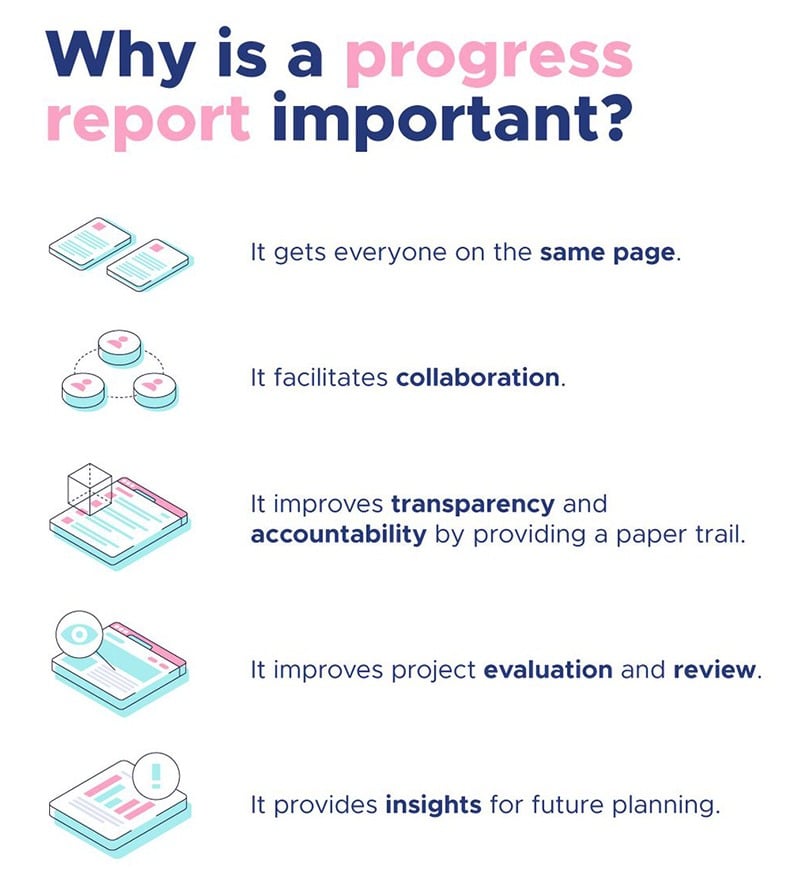
Progress reports play a vital role in project management, serving as a communication tool to keep stakeholders updated. Let's delve into why progress reports are crucial for the success of any project or business.
Transparency and Accountability
Progress reports eliminate ambiguity and promote transparency. By regularly sharing project updates with stakeholders, the project team is held accountable for their work. This accountability ensures everyone is on track to meet the project milestones and objectives.
Identify Potential Issues Early
Progress reports help identify potential problems before they escalate. Team members can spot bottlenecks, delays, and other issues by examining project data and analyzing the progress report.
Early detection enables the team to take prompt action and prevent these issues from derailing the project.
Effective Decision-Making
Armed with accurate and timely information from progress reports, project managers and stakeholders can make informed decisions.
When a project progresses smoothly, management can allocate resources more efficiently or plan for future phases. On the other hand, if a project encounters challenges, swift decisions can be made to reallocate resources or change course.
Maintaining Momentum
A progress report's important aspect is maintaining momentum. When team members see their progress documented and shared, it fosters a sense of accomplishment and motivation.
This positive reinforcement encourages teams to keep pushing forward and maintain their productivity.
Improved Communication and Collaboration
Progress reports facilitate better communication and collaboration among team members. By sharing updates and insights, the entire team stays informed, reducing the chances of miscommunication or misunderstandings.
Moreover, progress reports provide a platform for team members to ask questions, provide feedback, and offer support.
Performance Tracking
Business progress reports, such as quarterly, monthly, or annual progress reports, help track performance over time.
By comparing past reports, management can gauge the business's overall health and identify trends or patterns. This historical data can inform future strategies and drive continuous improvement.

How to Write a Progress Report
Step 1: define the purpose.
The first step in writing a progress report is understanding its purpose. Progress reports inform stakeholders about the project's status, including what has been accomplished, any challenges encountered, and future planning. This allows project managers to keep everyone in the loop and make informed decisions.
The purpose of this monthly progress report is to update the management team on the project's status. It presents an overview of completed tasks, in-progress tasks, upcoming tasks, and any challenges faced during the reporting period. This report will also provide insight into key performance metrics and future planning .
Step 2: Know Your Audience
Determine who will read the progress report. Is it for higher-ups, clients, or team members? Tailor the language, tone, and level of detail accordingly.
Step 3: Set the Timeframe
Decide the reporting period – weekly, monthly, or quarterly. Choose a timeframe that best suits your project's pace and stakeholder expectations.
Step 4: Collect Information
Gather data on tasks completed, team members involved, and any obstacles faced. Consult previous progress reports, project documentation , and team members for accurate information.
Step 5: Organize Content
Break down the report into logical sections. Here’s what we suggest:
- Summary: A brief overview of the report's contents.
- Completed Tasks: List tasks accomplished during the reporting period.
- In-Progress Tasks: Describe ongoing tasks and their current status.
- Upcoming Tasks: Outline tasks scheduled for the next reporting period.
- Challenges: Discuss any obstacles encountered and how they were addressed.
- Key Metrics: Highlight key project performance indicators and progress towards goals.
- Future Planning: Discuss plans for the next reporting period and any adjustments needed.
Step 6: Write the Summary
Craft a concise summary that provides a snapshot of the report. Mention key achievements, challenges, and plans for the future. Keep it brief but informative.
This progress report covers our team's accomplishments during Q1, with a particular focus on the completion of the website redesign and the initiation of our social media marketing campaign. We've encountered some challenges in coordinating with external vendors, but we've implemented solutions to overcome those obstacles .
Step 7: Detail Completed Tasks
List all tasks completed during the reporting period. Include the following information:
- Task description
- Team members involved
- Start and end dates
- Any relevant metrics (e.g., hours spent, budget used)
- Task 1 – Implement a user login system.
- Team members: Jeff and Sarah.
- Start date: January 1st.
- End date: January 15th.
- Metrics: 98% successful login rate.
Step 8: Discuss In-Progress Tasks
Outline ongoing tasks, their current status, and expected completion dates. Explain any delays and their impact on the project timeline .
- Task 2 – Develop a mobile app.
- Current status: 70% completed.
- Expected completion date: February 15th.
Step 9: Describe Upcoming Tasks
Identify tasks scheduled for the next reporting period. Provide details such as:
- Assigned team members
- Estimated start and end dates
- Dependencies on other tasks
- Task 3 – Launch marketing campaign.
- Assigned team members: Anas and Mark.
- Estimated start date: February 16th.
- Estimated end date: March 1st.
- Dependencies: Completion of mobile app development.
Step 10: Address Challenges
Discuss any challenges encountered during the reporting period. Describe how they were resolved or any plans to address them in the future.
- Challenge 1 – Unforeseen technical issues causing delays.
- Resolution: Increased resources and adjusted project timeline to accommodate the additional time required.
Step 11: Present Key Metrics
Highlight key project management performance indicators and progress toward project goals. Use visuals like charts or graphs to make the data more digestible.
- Metric 1 – User registration rate.
- Current status: 500 new users per week.
- Target goal: 1,000 new users per week.
Step 12: Plan for the Future
Discuss plans for the next reporting period, including any adjustments required. This may involve reallocating resources, revising timelines, or redefining objectives.
In the next reporting period, our focus will shift to improving user retention and engagement. We plan to implement new features based on user feedback and optimize the onboarding process.
Step 13: Proofread and Revise
Review the report for clarity, accuracy, and readability. Ensure all information is presented in a clear, concise manner.
Step 14: Submit the Report
Submit the progress report to the relevant stakeholders, ensuring they have ample time to review and provide feedback.
Example Progress Report Template
Use this template as a starting point for your progress report:
By following these steps and guidelines, you'll be well-equipped to write an effective progress report that keeps stakeholders informed and drives project success. Clear communication is key to maintaining momentum and ensuring everyone is on the same page.
Examples of Progress Reports
1. business progress report.

A business progress report helps track company growth, accomplishments, and areas for improvement. It includes:
- Revenue and sales figures.
- Market trends and competition.
- Operational efficiency.
- Employee performance.
- Goals and milestones achieved.
2. Quarterly Progress Reports

These reports offer a snapshot of a project or business every three months. They cover:
- Major achievements.
- Challenges faced and solutions.
- Key performance indicators (KPIs).
- Updated project timeline.
- Budget status.
3. Monthly Progress Reports
Monthly progress reports provide more frequent updates on projects or departments. They highlight:
- Accomplishments and setbacks.
- Progress towards monthly goals.
- Resource utilization.
- Issues and risks.
- Action items for the upcoming month.
4. Project Status
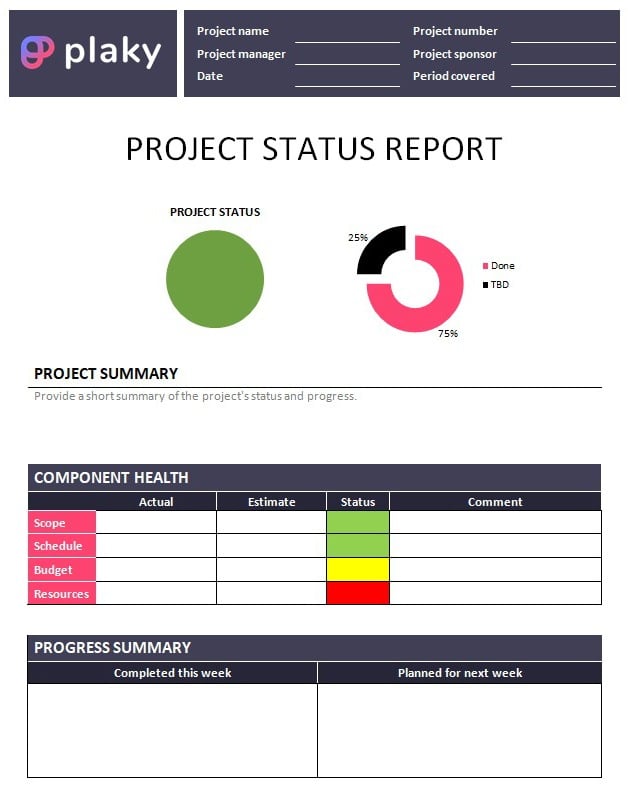
Project status reports focus on a specific project's progress. They showcase:
- Project documentation updates.
- Completed tasks and upcoming deliverables.
- Risks and issues encountered.
- Team members' performance.
- Changes to project scope or timeline.
5. Personal Progress
Personal progress reports help individuals track their growth and development. They include:
- Personal goals and objectives.
- Achievements and lessons learned.
- Skill development and training.
- Performance feedback.
- Areas for improvement and action plans.
Best Practices for Writing Progress Reports

Know Your Target Audience
When you create a progress report, start by identifying your target audience . Project stakeholders, team members, and future decision-makers should all benefit from your report.
Write in such a way that it is easy for them to understand. Avoid technical jargon and explain industry-specific language so everyone stays on the same page.
Reporting Frequency and Dates
Establish a reporting frequency for your progress reports. Whether weekly, bi-weekly, or monthly, maintain consistency. Include report dates and the expected completion date of the current project to provide a clear timeline.
Stick to the Project's Scope
Focus on the project's scope and stay within the project's purpose. Don't digress or include unrelated details. A concise report ensures that readers remain engaged and informed.
Review Previous Reports
Refer to the previous report to identify any changes or developments. Highlight the work completed, project deliverables , and any updates to the project plan. Doing so will maintain continuity and keep stakeholders informed about the department's progress.
Prioritize and Organize
Arrange project priorities logically, focusing on the most critical aspects first. Organize the information in a clear, easy-to-follow format. Use headings, subheadings, and bullet points for better readability.
Be Transparent About Problems
Don't shy away from discussing problems or challenges. Addressing issues helps stakeholders understand the project's status and any hurdles that may affect successful completion. Offer potential solutions or workarounds to demonstrate proactive thinking.
Back Up Progress with Relevant Data
Use relevant data to support your progress. Figures, charts, and percentages can provide a quick overview of the project's status. Make sure your data is accurate, up-to-date, and presented in an easy-to-understand format.
Highlight Team Member Contributions
Acknowledge team members who have made significant contributions to the project. This recognition boosts morale and encourages continued excellence.
Include Future Projections
Discuss what's next for the project, such as upcoming tasks or milestones. This helps stakeholders understand the trajectory of the project and anticipate the work ahead.
Keep it Simple and Actionable
Present complex ideas in a simple, easy-to-understand language. Break down complicated concepts into manageable chunks. Offer actionable insights and practical takeaways, so stakeholders can quickly grasp the project details.
Establish a Database
Create a database to store all progress reports. This repository helps stakeholders access past reports and provides valuable insights for future projects. It also ensures that information is preserved and easily accessible when needed.
Proofread and Edit
Before sharing your progress report, proofread and edit for clarity, consistency, and accuracy. This step ensures that your report is polished, professional, and easy to understand.
Progress Reporting FAQs
A progress report is most valuable when you're working on a long-term project. It's a way to keep stakeholders updated on progress and share important insights.
The primary purpose of a progress report is to provide a clear and concise overview of a project's status. This includes: – Communicating progress toward goals – Identifying potential issues and solutions – Demonstrating accountability and commitment to the project – Providing a step-by-step guide of completed tasks and upcoming work – Offering visual aids, like charts and graphs, to illustrate data A well-crafted progress report keeps stakeholders informed and fosters collaboration. It's also valuable for maintaining momentum and motivation throughout the project.
Writing Progress Reports Does Not Need to Be Hard
So, you've reached the end of this blog post. You're now equipped with the knowledge and tools to make progress report writing a breeze. Remember, it doesn't have to be a daunting task.
Keep it simple, stick to the facts, and let your progress shine. Talk about what you achieved, any challenges you faced, and how you overcame them. Use a clear, concise, structured format to ensure your message is easily understood.
To simplify the process, check out our guide on project reporting tools .
Ask yourself:
- What are the key takeaways from this period?
- How can I best communicate the status of the project?
- Are there any challenges that need addressing?
Considering these questions will make your progress report informative, actionable, and engaging. And don't forget, practice makes perfect. The more progress reports you write, the easier and more efficient the process will become.
Explore Further
- Essential Components of Project Management
- Best Project Management Software 2023
- The Inspiring History of Project Management. How Did It Begin?
- 9 Essential Roles In Project Management
Was This Article Helpful?
Martin luenendonk.
Martin loves entrepreneurship and has helped dozens of entrepreneurs by validating the business idea, finding scalable customer acquisition channels, and building a data-driven organization. During his time working in investment banking, tech startups, and industry-leading companies he gained extensive knowledge in using different software tools to optimize business processes.
This insights and his love for researching SaaS products enables him to provide in-depth, fact-based software reviews to enable software buyers make better decisions.
👀 Turn any prompt into captivating visuals in seconds with our AI-powered design generator ✨ Try Piktochart AI!
- Piktochart Visual
- Video Editor
- AI Design Generator
- Infographic Maker
- Banner Maker
- Brochure Maker
- Diagram Maker
- Flowchart Maker
- Flyer Maker
- Graph Maker
- Invitation Maker
- Pitch Deck Creator
- Poster Maker
- Presentation Maker
- Report Maker
- Resume Maker
- Social Media Graphic Maker
- Timeline Maker
- Venn Diagram Maker
- Screen Recorder
- Social Media Video Maker
- Video Cropper
- Video to Text Converter
- Video Views Calculator
- AI Brochure Maker
- AI Document Generator
- AI Flyer Generator
- AI Infographic
- AI Instagram Post Generator
- AI Newsletter Generator
- AI Report Generator
- AI Timeline Generator
- For Communications
- For Education
- For eLearning
- For Financial Services
- For Healthcare
- For Human Resources
- For Marketing
- For Nonprofits
- Brochure Templates
- Flyer Templates
- Infographic Templates
- Newsletter Templates
- Presentation Templates
- Resume Templates
- Business Infographics
- Business Proposals
- Education Templates
- Health Posters
- HR Templates
- Sales Presentations
- Community Template
- Explore all free templates on Piktochart
- Course: What is Visual Storytelling?
- The Business Storyteller Podcast
- User Stories
- Video Tutorials
- Need help? Check out our Help Center
- Earn money as a Piktochart Affiliate Partner
- Compare prices and features across Free, Pro, and Enterprise plans.
- For professionals and small teams looking for better brand management.
- For organizations seeking enterprise-grade onboarding, support, and SSO.
- Discounted plan for students, teachers, and education staff.
- Great causes deserve great pricing. Registered nonprofits pay less.
Progress Report: How to Write, Structure, and Make Project Progress Visually Attractive
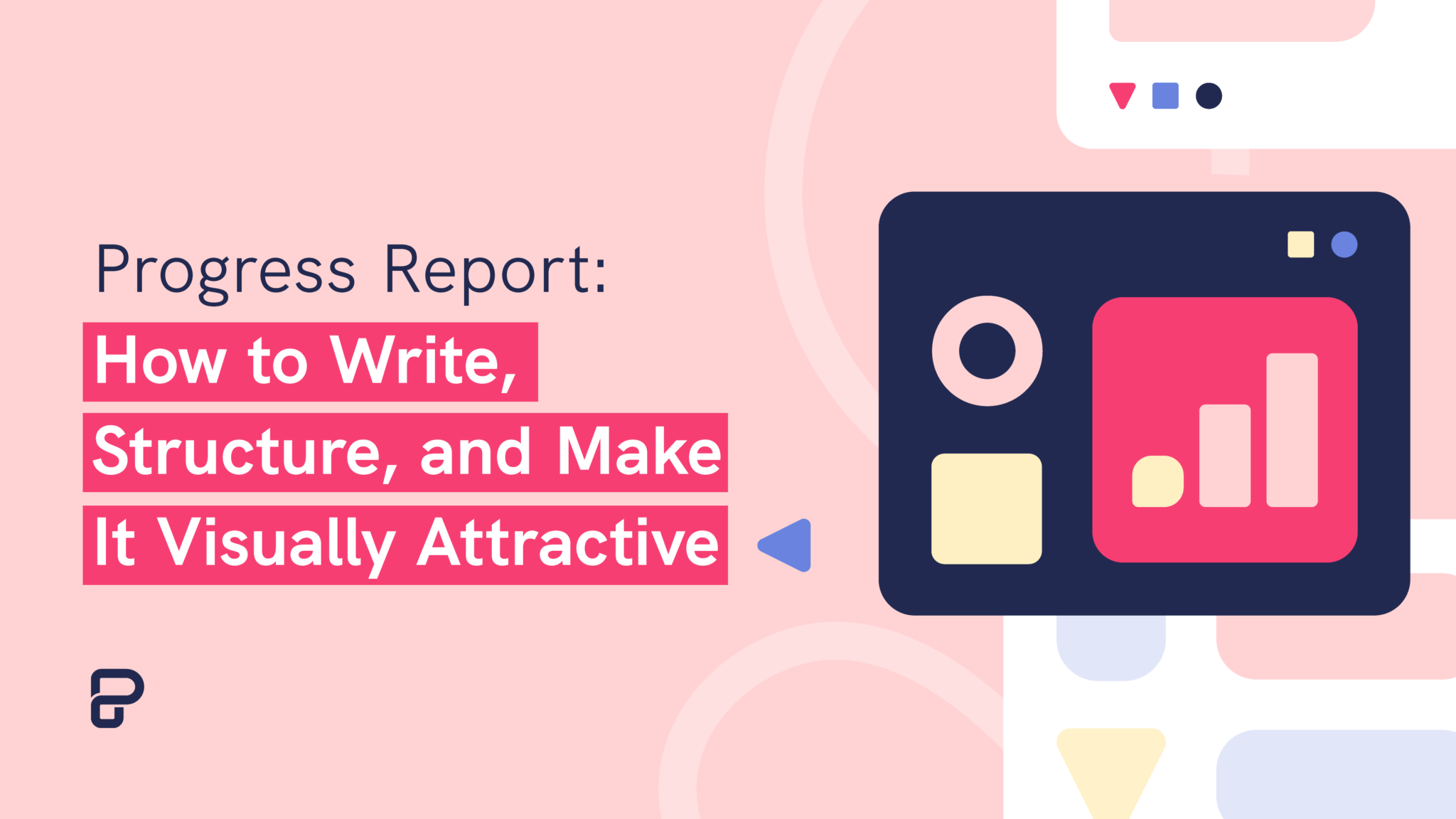
Picture this: Days or weeks into a project, your supervisor asks for a progress report.
Depending on your experience with writing progress reports, you might respond with readiness, anxiety, or confusion. Where do you begin? How do you know you’ve created a satisfactory or even amazing final report? Fear not—the expert team here at Piktochart is here to help.
In this progress reporting guide, we’ll not only give you top tips on how to write a successful report but additionally provide you with progress report templates and checklists to keep you focused on the important stuff. We begin, of course, with the all-important question anyone from a newbie to even a seasoned professional might have: “What is a progress report?”
Table of contents:
What is a progress report, why is a progress report important.
- How to write a progress report
- How to structure a progress report
- Free progress report templates you can edit right away
Progress report checklist
In case you prefer watching over reading, feel free to check out the video summary of this blog post:
A progress report is exactly what it sounds like—a document using simple and straightforward language that explains in detail what has been achieved and what else is needed for project completion. Essentially this document is a status update before the final report, outlining tasks completed by a team member, project manager, or team, along with what else needs to be done.
W hether you need to provide daily progress reports or even quarterly progress reports, this asset outlines the activities you’ve carried out, the tasks you’ve completed, and the milestones you’ve reached vis-à-vis your project plan .
Depending on the scope and complexity of the project, you might need to give a progress report weekly or monthly or for every 25% project milestone.
In terms of audience, a progress report is typically written for a supervisor, colleague, or client. Progress reports can be written from the perspective of one person as well as an entire team or department.
Throughout your career, you’re likely to be creating more reports than you can count (challenge for you: count them and find how many resources you’re using!).
Perhaps you find yourself spending more time crunching data and plugging numbers into graphs than actually working.
Reports don’t have to be as time-consuming as they often are. Progress report templates are time-savers! Get your free Piktochart account so you can follow along as we share more templates below.
We also tapped into the brilliance of Kevan Lee of Buffer in this interactive content experience to help you with your progress report projects.
Dive right in here, and learn some reporting hacks from Kevan .
Sometimes it might feel like writing about your progress in detail is redundant, especially when you’ve been regularly communicating with your supervisor, teammates, and client throughout the course of the project. Like any project manager, you probably think there are more important things to work on.
But this type of professional report is actually quite useful for several reasons.
1. It gets everyone on the same page
Each person who receives a copy of the report will know what has been accomplished and what is remaining. This prevents confusion about what has been or has yet to be done. Additionally, it provides proof and data about the respective project that can be cited and sourced if and when questions arise in the future.
2. Writing progress reports facilitates collaboration
This is especially important when different teams or departments work together. Knowing what another team is prioritizing helps prevent working in silos and also reduces task redundancy. Additionally, progress reporting helps a team identify areas where it can offer help or collaborate with others.
When teams can track progress on where other teams are on the project timeline, project managers get a better idea of the current status. They can reassign resources to make sure everyone is on track to hit the deadline for the current project, which can be tricky if you’re managing remote teams .
If you’d like to learn more about how you can work together with your team on a report, sign up for a free Piktochart account and try our online report maker .
3. It improves transparency and accountability by providing a paper trail
When you submit your report, you’ve placed on record that you’ve accomplished a task or explained why your results were different than expected. Once the document has been accepted, it becomes part of the project’s official documentation.
So, just in case someone accuses you in the future of failing to accomplish a task or not reporting a problem, you can point to the progress report as proof that you did so.
On the flip side, if your project ever gets nominated for an award, you can be sure validators will come seeking documents that explain how the entire thing was accomplished.
4. It improves project evaluation and review
Next time you plan for a project, your team can examine documents, including progress reports, of previous projects to find out what was done right, what went wrong, and what can be improved.
Previous reports can shed light on systemic issues, loopholes, and other causes of delay or failure—both internal and external—that must be avoided or resolved.
5. It provides insights for future planning
When the supervisor knows what tasks have been accomplished, he or she can focus on monitoring progress toward the next stages of the project.
When a report shows that delays have occurred, the supervisor is able to investigate the problems that hindered progress and take steps to prevent them from happening again in the future.
The supervisor will also be able to adjust the project timeline if absolutely needed or instruct teams to double down.
Ultimately, all the valuable insights from the project documentation can increase the chance of success for future projects.
Here is a progress report format example:

How to write progress report s
Have you ever found yourself stuck tapping your pen or staring at a blinking cursor, unable to begin writing?
Writer’s block is not an unusual experience when creating progress reports, especially for those whose jobs typically don’t involve drafting a long document or creating a formal report.
One reason people may find it difficult to write these reports is the thought that they’re not ‘writers.’ Yet, this is simply a negative mindset.
Reports don’t require sophisticated language—in fact, the simpler, the better.
Here are some writing tips on progress reporting:
“Piktochart is my go-to tool when I’m looking for a way to summarize data that is easy for our upper management to review. Piktochart provides me with the tools to display data in a creative, visually appealing way.” – Erica Barto, Selection, Testing & Assessment Specialist at Valero Energy Corporation Create a report, presentation, infographic, or other visuals online with Piktochart. You don’t need any graphic design experience to make professional visual content. Sign up for free .
1. Think of it as a Q&A
Before you start worrying about your reporting frequency and whether you should provide monthly reports or weekly reports, take a step back and focus on the purpose of the report itself.
In essence, the reporting process comes down to Q&A; you’re answering key questions about your progress. Imagine your manager, colleagues, or client asking you their most important questions, and you’re simply providing them with answers on the project status.
For example, let’s say that you’re organizing a weekend fair with food stalls and music and that you’re put in charge of food concessions.
The project plan might require you to have secured letters of intent (LOI) from at least 10 businesses by the end of the first month.
Your progress report would then outline the companies or entrepreneurs who have sent LOIs, including a description of their businesses and plans for their food stalls. If talks are in progress with other businesses that haven’t yet sent LOIs, you can include that and explain when they’re expected to send in their letters.
On the other hand, if you haven’t met your target, you’d have to explain why but also narrate the efforts you have exerted and the expected timeline for achieving the desired results.
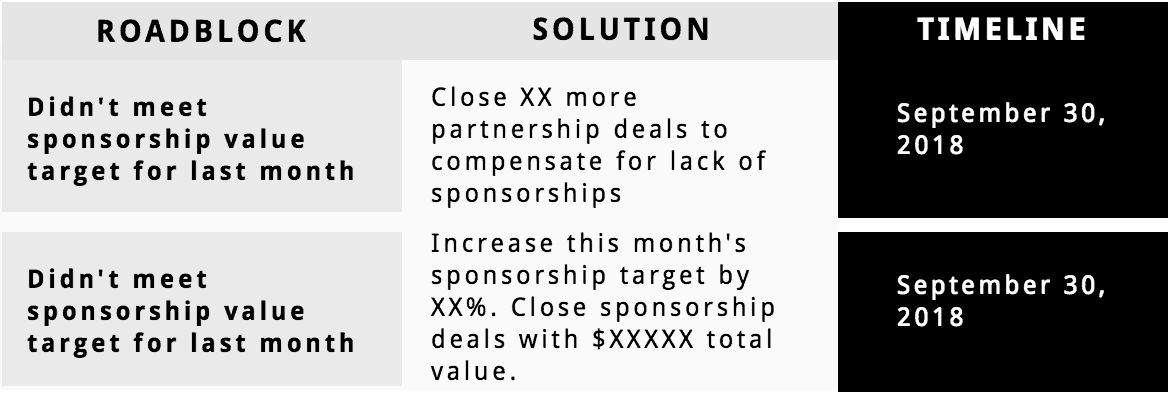
2 . Use simple and straightforward language
This doesn’t mean you can’t use technical jargon.
For example, if you’re in the construction business, you don’t have to avoid using terms like “tender” or “variation” or “risk management.”
But otherwise, speak plainly. Use clear and concise language.
One misconception in business writing is that complexity impresses. In truth, it only causes confusion. Fact is, being able to speak plainly about your subject indicates that you understand your subject matter inside out.
Let’s get specific. One thing that makes business documents dreary is the transformation of verbs into nouns—just like I did there.
If we had to rephrase that to keep the verb, we’d write, “transforming verbs into nouns.” It sounds simpler and gets to the point.
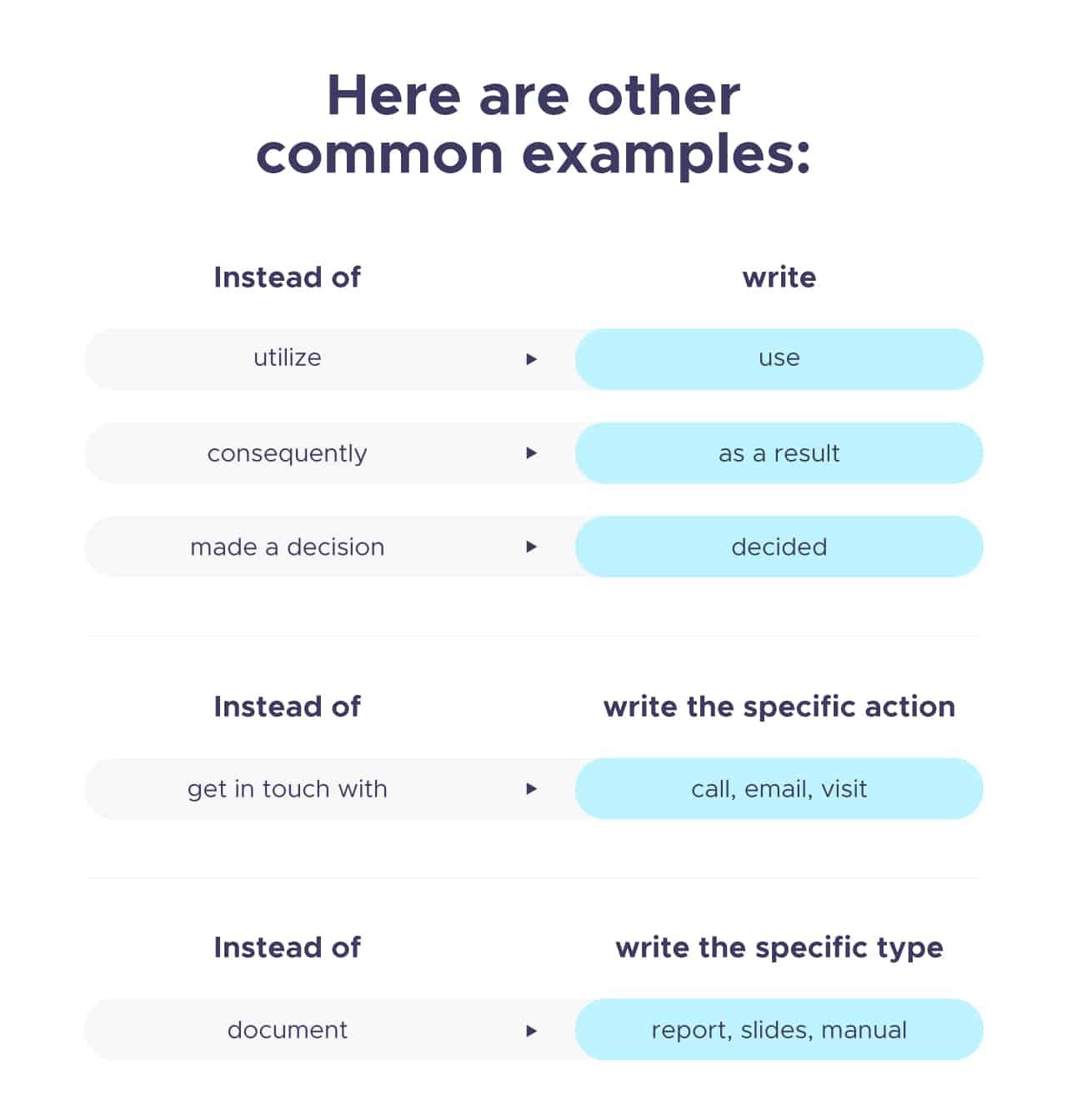
3 . Avoid using the passive voice where possible
Sometimes, you can’t avoid using the passive voice in formal documents that prohibit the first-person point-of-view. But when done well, it helps to make your progress reports more relatable.
Going back to the food concession example, a passive sentence would read: “Research on potential food concessionaires was carried out.”
To make that sentence active, give it an actor (which is the team in this case), as in: “The team researched on potential food concessionaires.”
4. Be specific
A study published in the Journal of Cognitive Neuroscience found that when you use concrete words, you tend to engage both the left and right parts of the brain, while the right region tends to remain unstimulated by abstract words.
While the jury is still out on exactly how word meanings are represented in the mind, we can agree that the phrase “a merry sound” doesn’t stir the imagination as much as “tinkling bells”.
“A hot day” doesn’t activate visual imagery as much as “a melting popsicle” does. When a reader’s mind is stimulated by words, it’s less likely to drift off.

Taking the previous example, “researched on potential food concessionaires” doesn’t evoke a visual image. Meanwhile, “built a list of 50 potential food concessionaires” is more concrete, especially when you add details of what food items might be sold.
5. Explain jargon if needed
This depends on who will be reading your progress reports, and if you’re using very specialized jargon that only members of your team would be familiar with.
For example, in a report written by a construction team addressed to the project manager , construction jargon could be used as the recipient obviously understands it.
6. Spell out acronyms when they first occur in the document
Don’t assume that every single person reading the report will understand all the acronyms you use without you spelling them out.
For instance, in construction work, SWMS should first be spelled out as “safe work method statement”. ‘Pre-starts’ should be spelled out as ‘pre-start checks’. So in your report, it would look like this: “safe work method statement (SWMS)”, then all subsequent references are free to just be SWMS.
7. Stick to facts
Avoid providing an opinion, unless it’s part of the project.
For instance, your task might be to analyze data and offer your interpretation and prediction. In that case, you can offer your speculation and point of view, as long as you have evidence to back you up.
8. Use graphics to supplement the text
Avoid writing down a long series of numbers in a sentence. Try using different types of graphs , tables or charts, especially when dealing with a series of numbers.
Here at Piktochart, we have many progress report templates, and the hiring progress report below is a great example.
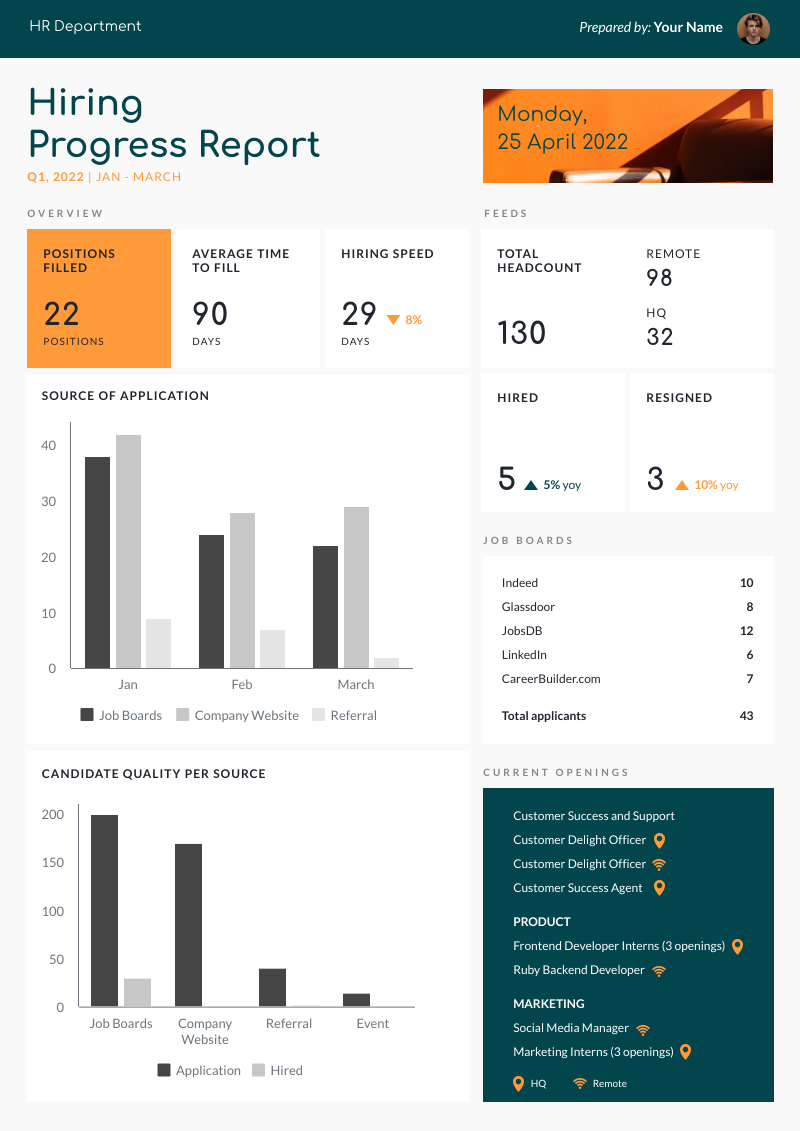
When using graphs or charts, try out several types to determine which ones best present your data. You might use a bar graph , pie chart , line graph , or even scatter plot . When doing so, though, spend time distinguishing different data sets from the others by using labels and colors.
Don’t worry if this sounds daunting—there are plenty of software that can help you visualize data , including the most basic examples, MS Excel and Numbers for Mac.
How to structure progress report s
You may still be wondering about the exact process of how to write a progress report. Armed with all of these practical tips, how do you put the report together?
First, it depends on the type of report, as well as the intended reader. A progress report may be written daily, weekly, or monthly. It may be written for an individual or a team.
As you’ll see in the examples below, the main parts of a progress report are:
1. Introduction
This part provides an overview of the contents of the progress report. It’s best to write this after you’ve completed all the other parts of the report. That way, you’ll be able to provide an accurate summary.
Keep it short and simple. One or two paragraphs will do.
2. Accomplishments
Numbers and details are your friends, especially when writing this section of the progress report. The accomplishments you write should correspond to your goals.

What were your goals for the period covered by the report?
This could be a goal for the day, week, month, or quarter. On the other hand, it could be a team goal, too.
Be concrete when writing goals. For instance:

Avoid providing too much detailed information. The simpler this section is, the easier it is for stakeholders and the project team to see the project priorities.
4. Roadblocks
Explain what situations, if any, prevented you from achieving your goals, or may have hindered the project’s progress.
But don’t stop there. Be proactive and present an action plan and timeline for resolving the roadblocks. Include details, such as funds, materials, and human resources you may need to implement the solution.
Progress reporting templates you can edit right away
To guide you better, here are progress report template examples that are visually attractive and highly readable.
These templates are available if you sign up for a free Piktochart account . Once you log in, use any of the templates below and edit the elements and text to make it your own.
1. Daily progress report s
A daily progress report includes your goals for the day, as well as your accomplishments the previous day. It also explains challenges encountered in performing tasks and achieving goals.
Another section under the daily report is ‘lessons learned’. These need to be directly related to the day’s tasks and challenges, as well as to the previous day’s accomplishments.
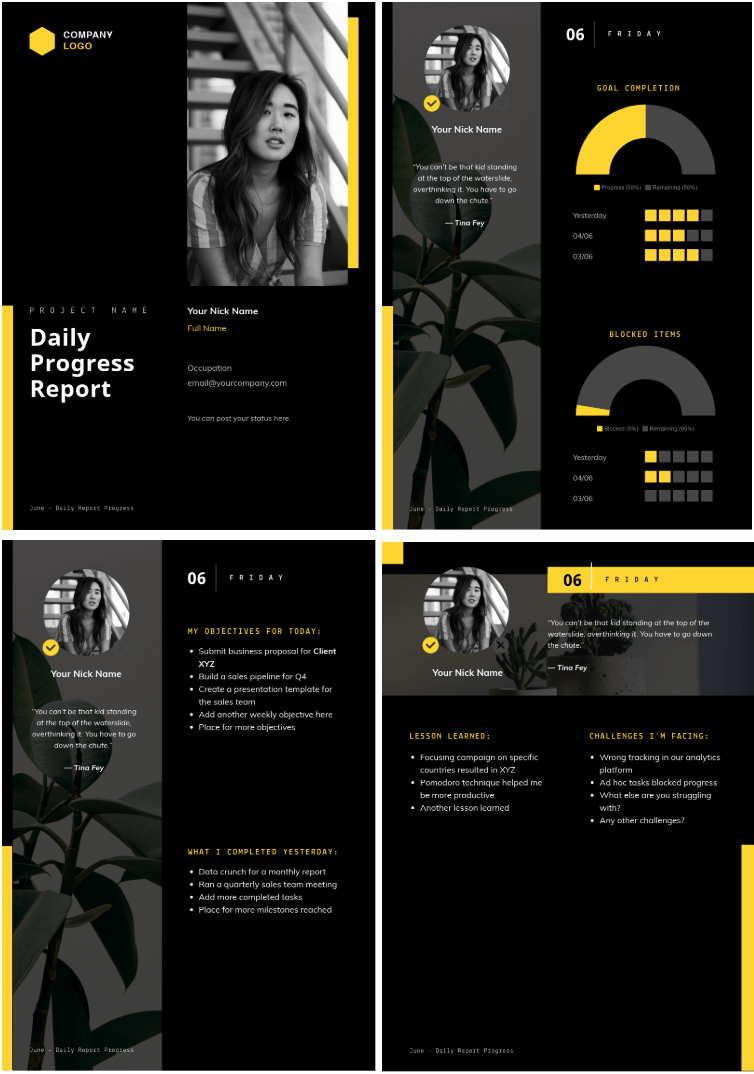
2. Weekly progress report
Weekly progress reports provide a week-by-week breakdown of what has been accomplished and what tasks remain to be completed.
Just like a daily report, a weekly progress report may include challenges and lessons learned. Examples are included in the templates below.
To get a better idea of this, let’s go back to the events example:
- Many potential vendors were attending a week-long industry convention; couldn’t book meetings.
- Potential vendors didn’t read the entire email.

Lessons Learned
- Consider industry events when planning a timeline for contacting clients
- Introductory emails must be short and have readable formatting

3. Monthly progress report ing
A monthly report is necessary for projects with longer durations. The report may provide both monthly and quarterly data on project progress.
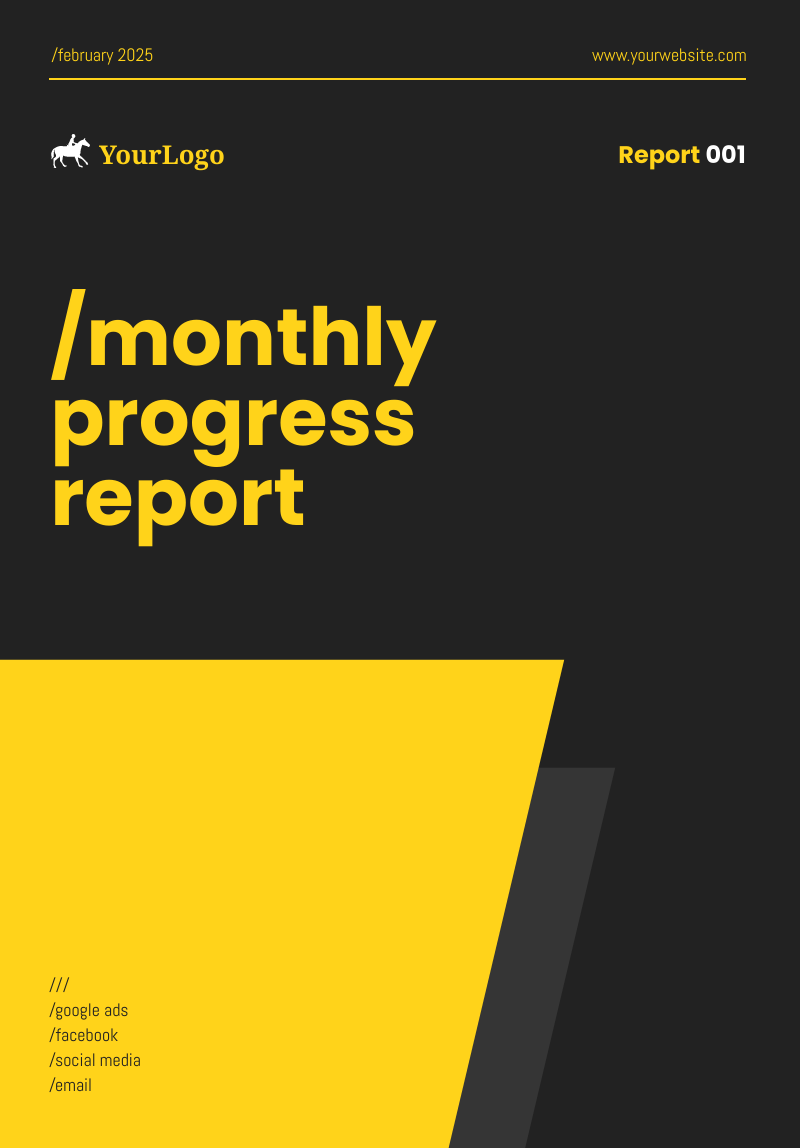
4. Team progress report s
Team progress reports provide information on both team and individual milestones and progress status. Now this one is more complicated, simply because it involves several people who may have worked on different tasks.
It’s not enough to just let one person make the report. Of course, one person can do the typing, but everyone must provide input and feedback.
One way to keep a record of different team members’ input is to keep track of edits they have made.
To do this, simply enable tracking of changes on a Word document, or on Pages for Mac users. When working on a collaborative tool like Google Docs , click the pencil icon on the top-right part of the window, and choose “Edits become suggestions” on the drop-down menu. Here’s what that looks like:
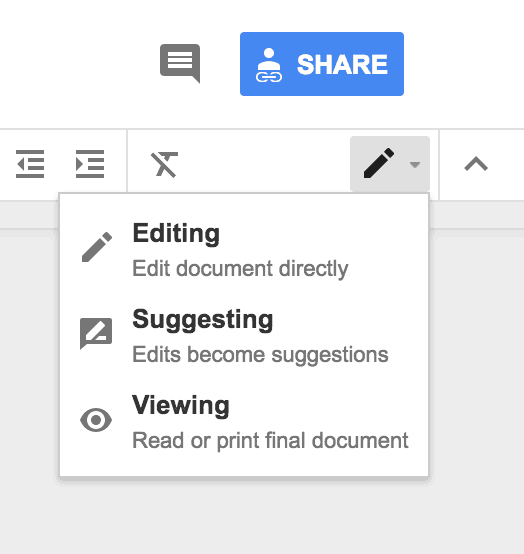
On the other hand, team members can insert comments or questions. Again, you can do this easily on a Word document, as well as on software that let you comment on shared documents, like Google Docs and Piktochart .
Here’s what it looks like in Piktochart (learn more about this feature in our guide to annotated comments for teams ):
Here’s one example of Piktochart’s many team project report templates .
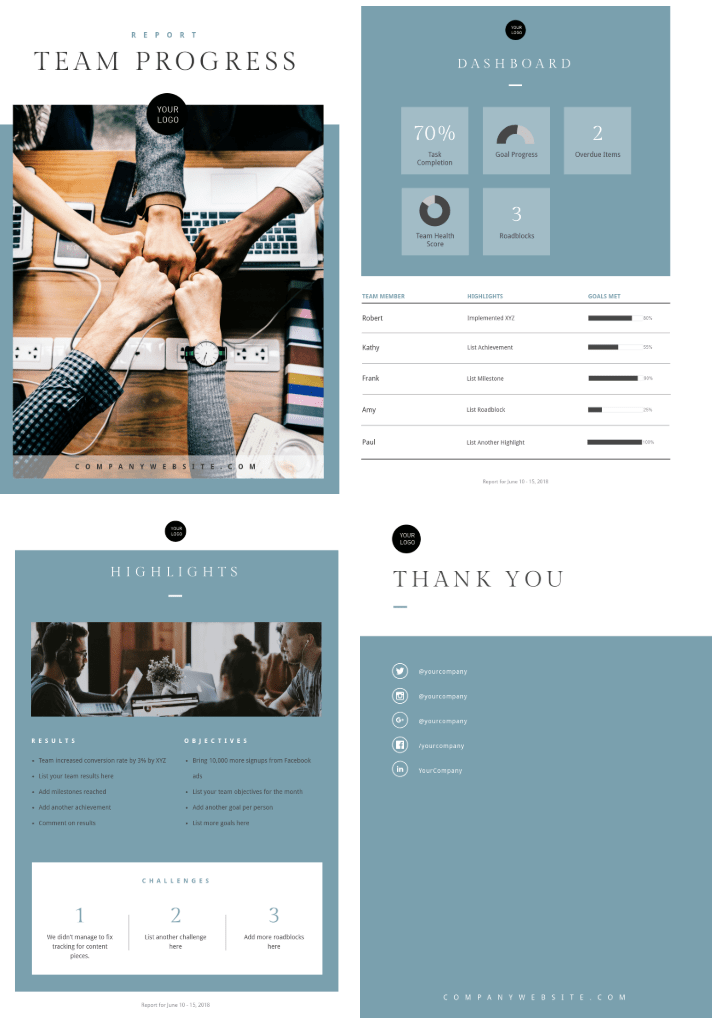
One last thing… You’ve finally finished typing up your report—breathe a sigh of relief, but don’t hit ‘send’ just yet.
Go over it at least once (better to do it more than once, especially if it’s a team report). Re-read the article, edit the content as needed, then ask a teammate to proofread with a fresh pair of eyes.
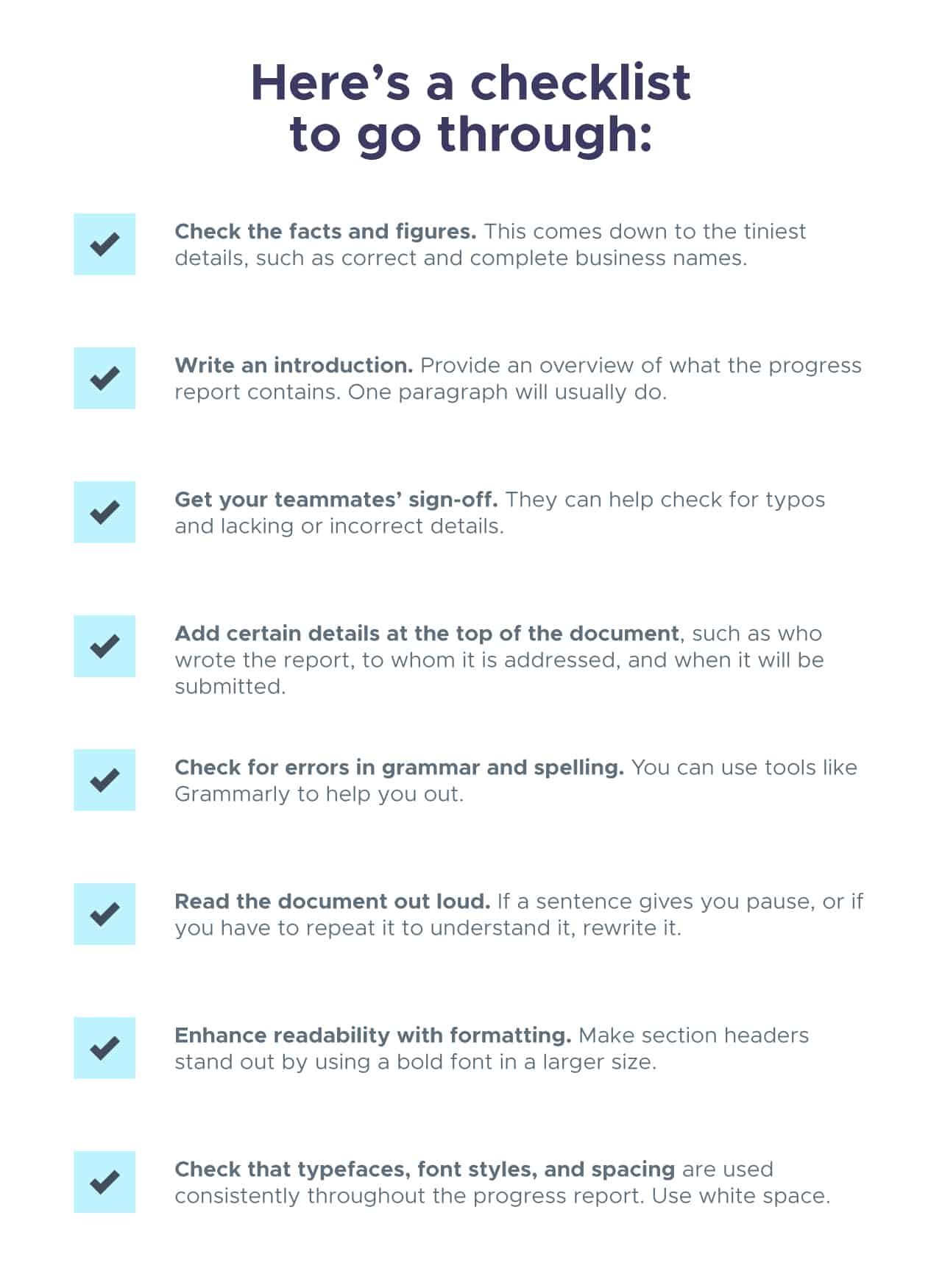
Other Posts

25 Green Color Palette Combinations (With Hexes and Name Codes)

How to Make Any Image Background Transparent

8 Best AI Banner Generators in 2024

How to tackle the PhD dissertation
Finding time to write can be a challenge for graduate students who often juggle multiple roles and responsibilities. Mabel Ho provides some tips to make the process less daunting

Created in partnership with

You may also like

Popular resources
.css-1txxx8u{overflow:hidden;max-height:81px;text-indent:0px;} Rather than restrict the use of AI, embrace the challenge
Emotions and learning: what role do emotions play in how and why students learn, leveraging llms to assess soft skills in lifelong learning, how hard can it be testing ai detection tools, a diy guide to starting your own journal.
Writing helps you share your work with the wider community. Your scholarship is important and you are making a valuable contribution to the field. While it might be intimidating to face a blank screen, remember, your first draft is not your final draft! The difficult part is getting something on the page to begin with.
As the adage goes, a good dissertation is a done dissertation, and the goal is for you to find balance in your writing and establish the steps you can take to make the process smoother. Here are some practical strategies for tackling the PhD dissertation.
Write daily
This is a time to have honest conversations with yourself about your writing and work habits. Do you tackle the most challenging work in the morning? Or do you usually start with emails? Knowing your work routine will help you set parameters for the writing process, which includes various elements, from brainstorming ideas to setting outlines and editing. Once you are aware of your energy and focus levels, you’ll be ready to dedicate those times to writing.
While it might be tempting to block a substantial chunk of time to write and assume anything shorter is not useful, that is not the case. Writing daily, whether it’s a paragraph or several pages, keeps you in conversation with your writing practice. If you schedule two hours to write, remember to take a break during that time and reset. You can try:
- The Pomodoro Technique: a time management technique that breaks down your work into intervals
- Taking breaks: go outside for a walk or have a snack so you can come back to your writing rejuvenated
- Focus apps: it is easy to get distracted by devices and lose direction. Here are some app suggestions: Focus Bear (no free version); Forest (free version available); Cold Turkey website blocker (free version available) and Serene (no free version).
This is a valuable opportunity to hone your time management and task prioritisation skills. Find out what works for you and put systems in place to support your practice.
- Resources on academic writing for higher education professionals
- Stretch your work further by ‘triple writing’
- What is your academic writing temperament?
Create a community
While writing can be an isolating endeavour, there are ways to start forming a community (in-person or virtual) to help you set goals and stay accountable. There might be someone in your cohort who is also at the writing stage with whom you can set up a weekly check-in. Alternatively, explore your university’s resources and centres because there may be units and departments on campus that offer helpful opportunities, such as a writing week or retreat. Taking advantage of these opportunities helps combat isolation, foster accountability and grow networks. They can even lead to collaborations further down the line.
- Check in with your advisers and mentors. Reach out to your networks to find out about other people’s writing processes and additional resources.
- Don’t be afraid to share your work. Writing requires constant revisions and edits and finding people who you trust with feedback will help you grow as a writer. Plus, you can also read their work and help them with their editing process.
- Your community does not have to be just about writing! If you enjoy going on hikes or trying new coffee shops, make that part of your weekly habit. Sharing your work in different environments will help clarify your thoughts and ideas.
Address the why
The PhD dissertation writing process is often lengthy and it is sometimes easy to forget why you started. In these moments, it can be helpful to think back to what got you excited about your research and scholarship in the first place. Remember it is not just the work but also the people who propelled you forward. One idea is to start writing your “acknowledgements” section. Here are questions to get you started:
- Do you want to dedicate your work to someone?
- What ideas sparked your interest in this journey?
- Who cheered you on?
This practice can help build momentum, as well as serve as a good reminder to carve out time to spend with your community.
You got this!
Writing is a process. Give yourself grace, as you might not feel motivated all the time. Be consistent in your approach and reward yourself along the way. There is no single strategy when it comes to writing or maintaining motivation, so experiment and find out what works for you.
Suggested readings
- Thriving as a Graduate Writer by Rachel Cayley (2023)
- Destination Dissertation by Sonja K. Foss and William Waters (2015)
- The PhD Writing Handbook by Desmond Thomas (2016).
Mabel Ho is director of professional development and student engagement at Dalhousie University.
If you would like advice and insight from academics and university staff delivered direct to your inbox each week, sign up for the Campus newsletter .
Rather than restrict the use of AI, embrace the challenge
Let’s think about assessments and ai in a different way, how students’ genai skills affect assignment instructions, how not to land a job in academia, contextual learning: linking learning to the real world, three steps to unearth the hidden curriculum of networking.
Register for free
and unlock a host of features on the THE site

IMAGES
VIDEO
COMMENTS
Skim them to identify which of the elements in the Introduction model on page 9 are present in each one. Label the main parts B (Background to the Research), RES (the Research), and REP (the Report). Then see which of the more detailed labels (e.g. identifying a research 'gap' or aims) you can apply.
The Presentation of PhD Progress Report to Doctoral Committee Members happens in three stages namely: i) Before the meeting: i.e. Once you start preparing the report for the meeting to till the meeting begins. ii) During the meeting: i.e. From entering into the meeting hall to till the meeting gets over and.
How to write and present PhD progress report once in 6 months happening under DRC or RAC research advisory committee panel. With sample presentation video a...
1. Abstract. Present the background of your research project, list its main goals, describe the methods to be used and the expected results as well as their impact for the field and beyond. 2. Progress to Date. Present the research work you have undertaken since your last progress report, describe the results obtained (including publications ...
Progress Report Guidance (2/2) Focus your work - combining two large pieces of work in a thesis statement is hard; better to focus on one aspect of the work, and clearly note the research direction and contribution. It is not generally necessary to link the report to the research proposal that was submitted as part of your PhD application.
Writing the progress report has many benefits. Writing the report will make you more productive, because it will force you to think about your work in a manner concretely enough to write down. ... (For PhD students, a periodic report to the members of your thesis committee can pay big dividends.) Writing the report helps explain (to yourself ...
At least one week prior to the annual meeting (which also includes the candidacy exam), the student will provide a brief progress report (3-page max, excluding non-mandatory figures), an updated CV, and a copy of their IDP. At the beginning of the meeting, the student will meet alone with the committee, followed by a meeting of the advisor (s ...
At the end of the first academic year, a formal assessment of progress is made. In the Department of Computer Science and Technology, this takes the form of a single document of no more than 10,000 words in length, exclusive of tables, bibliography and appendices. The document is principally a PhD Proposal. That is, a document that demonstrates ...
Yearly Progress Reports. Subsequently, you report on an annual basis on the progress of the doctoral research, and in addition, if required, when applying for or extension of a scholarship or mandate. You can also reach out to the members of the supervisory committee for additional discussions, which provides an opportunity to receive constructive academic feedback on the research conducted.
Mastering Your Ph.D.: Getting the Most Out of Progress Reviews. Y ou will meet with your supervisor from time to time to present data, exchange ideas, and discuss failures and possible solutions for moving forward with your thesis research. These regular discussions are key to your success as a Ph.D. student.
The preparation and submission of the Research Progress Report/Prelim Document emphasizes your research accomplishment at an early stage. The report also provides practice in technical writing, an important part of graduate training. The report serves as a first concrete step toward the preliminary examination, and the revised and updated version will also serve as the written document that ...
Briefly describe what progress you have made toward the completion of your thesis. Highlight the progress you have made since your last Annual Progress Report. (As part of the progress meeting, students who have completed their field study in a previous year are asked to submit a piece of written work for discussion with their committee.
Writing a PhD semester progress report involves summarizing your academic and research activities over the semester. This report is important for tracking your progress, identifying challenges, and planning future work. Contents for PhD Semester Progress Report. Here's a guide on how to structure and write an effective PhD semester progress ...
2. Write and successfully defend dissertation 3. Submit first author manuscript for publication 4. Present at regional/national conference 5. Continue to update professional portfolio 6. ----- 7. ----- _____ _____ Date Date . PhD Student Academic Advisor . REMINDERS • If you have completed predissertation, comps, and have been admitted to
You can learn about how to prepare a PhD progress report. To get my complete list of research related videos click here https://www.youtube.com/playlist?list...
University Hall, Tan Chin Tuan Wing Level 05, #05-03. 21 Lower Kent Ridge Road. Singapore 119077. Research Progress Report What it is? A Research Progress Report outlines the progress you have made towards your research work or thesis writing. Your.
Rules for reporting academic progress: o In the first term, new students will complete only the Course Selection Proposal form. o In every term but the first term, students must complete a term progress report or an annual progress report. o Annual progress report must be completed in winter term, starting in the second year onwards.
Thesis. Thesis is a type of research report. A thesis is a long-form research document that presents the findings and conclusions of an original research study conducted by a student as part of a graduate or postgraduate program. It is typically written by a student pursuing a higher degree, such as a Master's or Doctoral degree, although it ...
The thesis advisor(s) must also send their report, following the template "Model d'informe del director del seguiment anual RD 99/2011 (18/07/2013)", which outlines the progress that the PhD student has made and that endorses the student´s report Please consult the document "Procedure of the Evaluation of Academic Progress"
Six Monthly Progress Report of the Research work done for the period from 01 November 2017 to April 2018 of the Research Scholar. Name of the Research Scholar: Mr. Daniel Sehwag. Subject: Computer Science. Topic registered for Ph.D. Degree: Optimum web personalization system using semantic annotation. Research paper published during this tenure ...
A dissertation is a long-form piece of academic writing based on original research conducted by you. It is usually submitted as the final step in order to finish a PhD program. Your dissertation is probably the longest piece of writing you've ever completed. It requires solid research, writing, and analysis skills, and it can be intimidating ...
A progress report is a vital tool in project management, designed to keep different types of stakeholders informed about the ongoing status of a project. It's a concise document highlighting current achievements, challenges, and goals, allowing the project manager to track progress and make necessary adjustments.
1. Think of it as a Q&A. Before you start worrying about your reporting frequency and whether you should provide monthly reports or weekly reports, take a step back and focus on the purpose of the report itself. In essence, the reporting process comes down to Q&A; you're answering key questions about your progress.
You can try: The Pomodoro Technique: a time management technique that breaks down your work into intervals. Taking breaks: go outside for a walk or have a snack so you can come back to your writing rejuvenated. Focus apps: it is easy to get distracted by devices and lose direction.